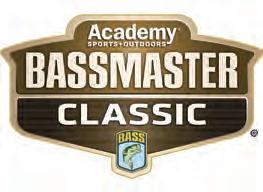










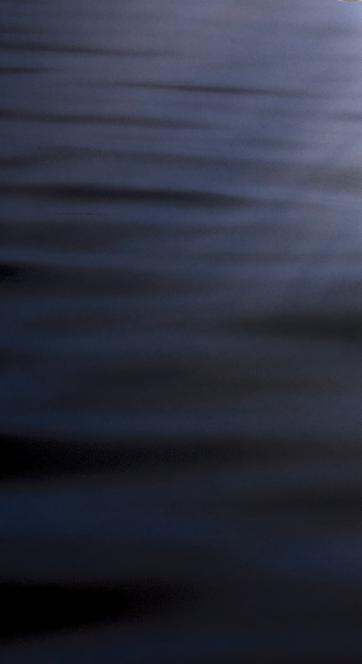



DRS4DNXTDRS6ANXT


You’re looking at it! Furuno’s award-winning Radar gives you clarity & target separation like no one else. Don’t take our word for it. See for yourself. Scan here, and we’ll show you!



























Do you love boating? Then you know how fun and relaxing it can be on the open water. But you also know that things can go wrong sometimes, like storms, accidents, theft, or injuries. That’s why boat insurance is so important. Here are some reasons why.
• Boat insurance can help you pay for damage to your boat, or to other boats or docks, up to specifed limits.
• If you borrowed money to buy your boat, your lender may require insurance. And if you want to explore different places, some marinas or waterways may ask you to show proof of insurance.
Progressive Casualty Ins. Co. and af fliates Coverages subject to policy terms and conditions.
• Boat insurance can also come in handy if you need an on-water tow, jump start, or fuel delivery with optional Sign & Glide® coverage. And if your boat sinks, boat insurance can pay for the cost of removing it from the water (if removal is legally required).
Get boat insurance from Progressive and enjoy the peace of mind that comes with it.
Scan to get a quote in as little as 4 minutes
Go to progressive.com to learn more.
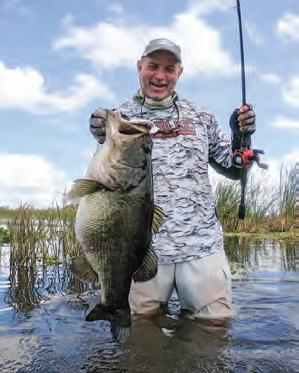









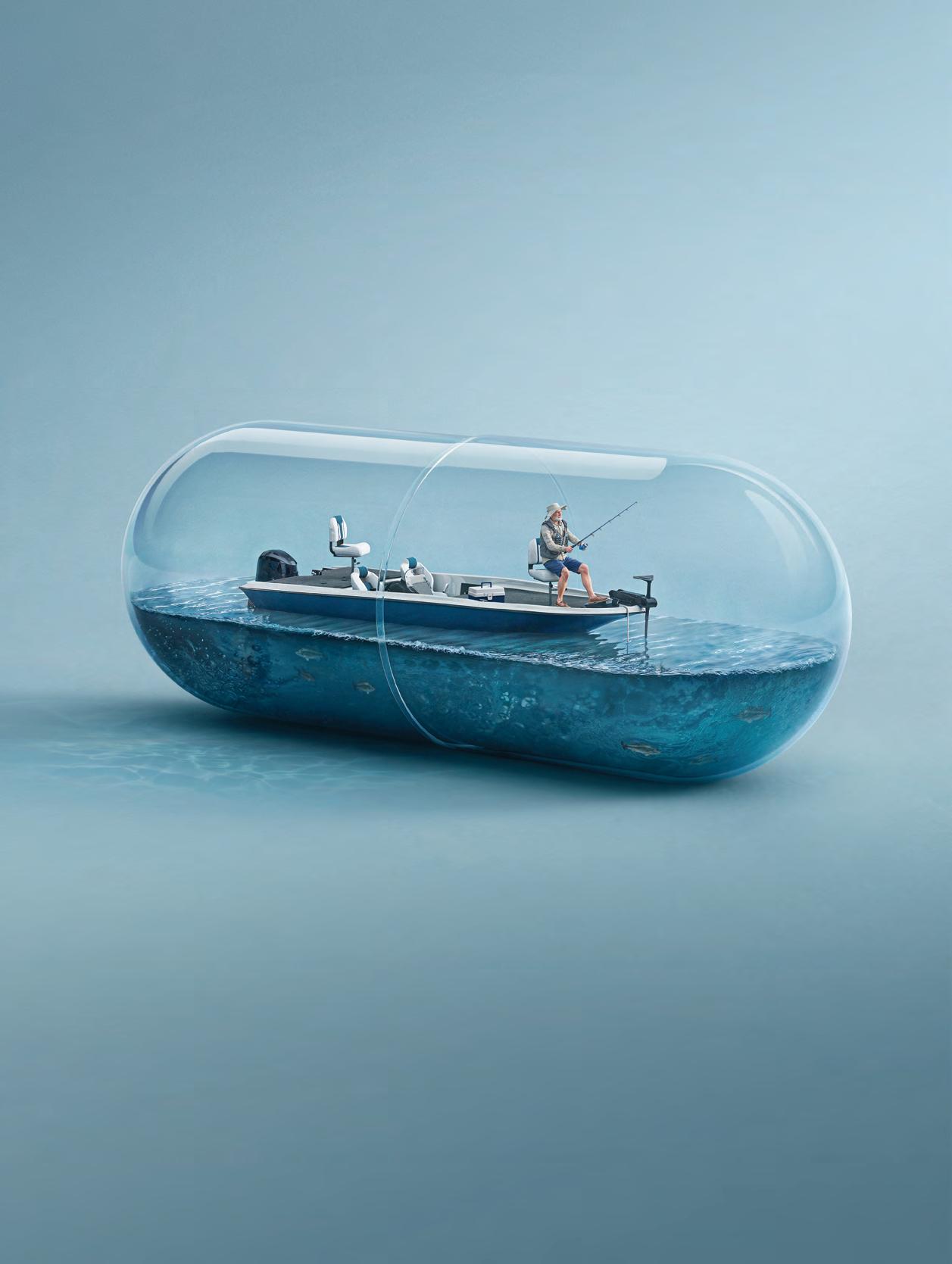















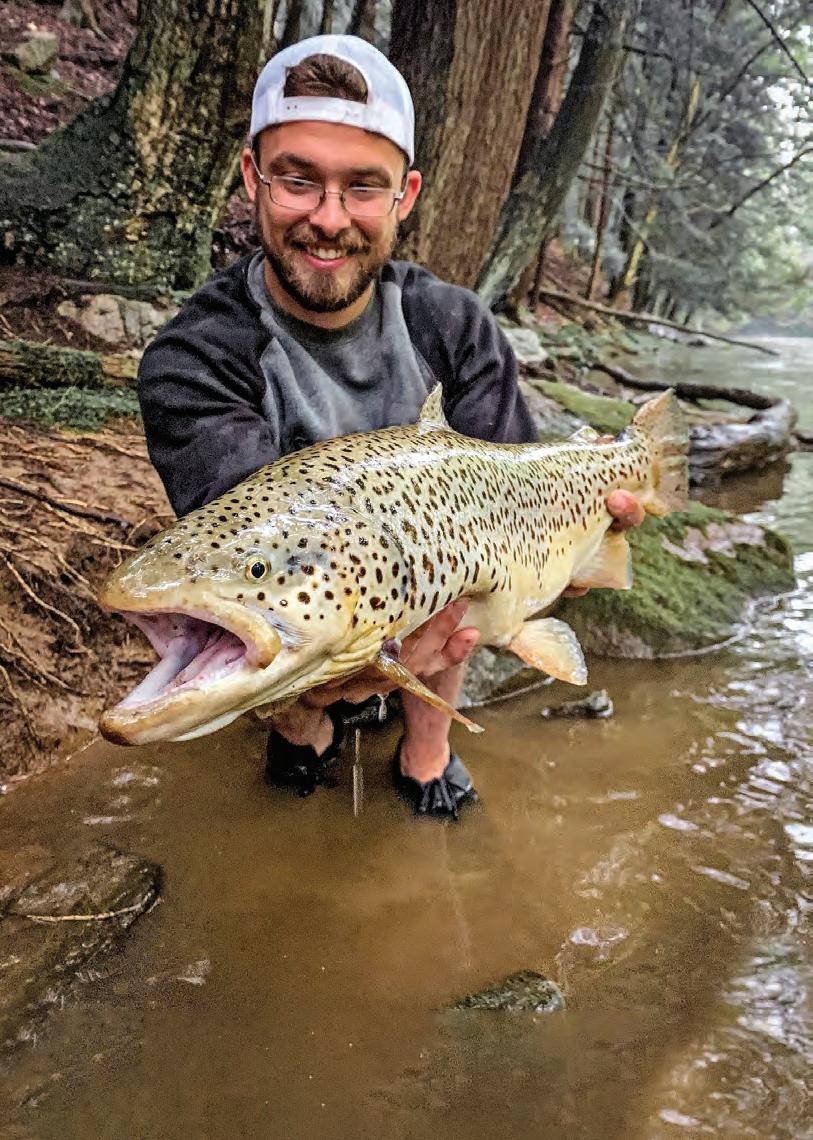

Trout don’t grow huge on a diet of insects alone, so Budkey fshes 2- to 3-inch-long bait lures to take advantage of the carnivorous tendencies of big fsh. Tese fsh have good eyesight, so he fshes 4-pound-test and said light line can be the diference between catching dozens of fsh or nothing at all.
Now… battling 10-pound trout in current with light line is tricky, to say the least.
“You really have to wear them out. you all the way down the creek and back up it, jumping and thrashing,” Budkey said. “If you try to muscle them, they’ll break you o

Part-time guide Stephen Budkey catches a lot of outsized trout fshing the streams of western Pennsylvania. Much of his success with giant 6- to 15-pound rainbows and browns has to do with location, but he also uses some interesting tactics that specifcally appeal to large fsh.
Te setting is on Lake Erie tributaries. Tese streams vary in size, but generally Pennsylvania is known for smaller fows. Te key to their productivity is the lake. Lake Erie feeder streams experience steelhead runs a lot like the rivers of the Pacifc Northwest. Fish grow large gorging on baitfsh in open water before pushing into tributaries in early fall to spawn. Te lakerun rainbow trout in this migration are called steelheads, and there are bruiser brown trout that run up out of the lake, as well. Budkey also has access to a stretch of privately managed tailwater, which is an obvious target-rich environment for very large trout. Regardless of where he’s fshing, he uses tactics and gear that might seem odd to
trout anglers in other regions.
If you’re a snooty fy fsher, set your tweed hat aside for a minute. Tis might not convince you to pick up a spinning rod, but Budkey has an undeniable knack for catching giant trout, and you might just learn or adapt something from his style of fshing.
Reading water in western Pennsylvania is the same as it is anywhere. Trout like the cold, welloxygenated water of broken water and rifes. When targeting large trout, Budkey said he looks for the deepest runs or waterfall holes in the creek he’s fshing.
“I’m talking about creeks that are sometimes just the width of your car, and these fsh will just stack up in there,” he said. “And when they stack up, they really stack up. It’s wild.”
Budkey said clients who are decent anglers can have 25-fsh days that include trout that might weigh 6 to 10 pounds. Most of these trout were originally stocked by the state, but there is some reproduction, and holdover fsh that have been in
To even the odds, Budkey fshes a 10-footlong noodle rod, which is extremely absorb shock during the fght and protect that light line. Another important factor is a big net for landing fsh, and it doesn’t hurt to have someone else to serve as net-man. Sometimes it’s not possible to bring big fsh to hand, and a net man can wade out to get them.
When trout are aggressive, they are super aggressive, Budkey said. He likes a good-old foating Rapala when the trout are actively chasing and fshes a 2-inch F05 or a 2.75-inch F07 tied on with a loop knot. He just throws it into the current, gives it a jerk to get it wobbling and lets it sit there until a fsh crashes it.

If fsh want something on or near the bottom, Budkey fshes jigs. Trout Magnet jigheads in 1/32 and 1/64 ounce—the lightest you can get away with—paired with Gulp! sof plastics are deadly. Trout are suckers for these scented plastics, and he likes the 2.5- and 3-inch minnows as well as Killer Crawlers and Pinched Crawlers.
Te technique with the jigs is slow. Budkey said he just wiggles the rod tip to give the lure some action.
“It’s almost like I don’t want to move the jig toward me very much, at all. I just want it to sit there and wiggle,” he said. “It’s like shaking a donut in someone’s face at the gym. Tey can’t handle it. Tey’ll run out and grab it.”
Afer the take, it’s time to start worrying about how to battle that fsh to the net on super-light line. Budkey said that is the most fun part of trout fshing, and he loves nothing more than showing other people how to experience it.
See some of Budkey’s tactics on YouTube @FishFightsPA.







In mid-June, NOAA Fisheries announced a one-day recreational season for red snapper in the South Atlantic. Although there was widespread grumbling and gnashing of teeth by recreational anglers, it did not come as a surprise to pretty much anyone.
First the season: Red snapper harvest will be open for recreational anglers in the South Atlantic, from North Carolina through Florida, on July 12. Te limit is one fsh per angler.
Te date is subject to change in case a small craf weather advisory is projected. Any change in the date of the recreational season will be announced in the Federal Register, Fishery Bulletin, and an announcement via NOAA Weather Radio.
Now the reasoning: In 2008, NOAA’s stock assessment indicated red snapper in the South Atlantic were in bad shape and devastatingly overfshed. Over the last 16 years, NOAA has essentially shut down recreational fshing for the species, and catch limits for commercial fshing have been kept very low. Not surprisingly, it worked! Populations rebounded to the point where data indicates red snapper are now more plentiful in the South Atlantic than at any time since such data existed. What’s more, the fshery continues to improve ahead of the projected recovery timeline.
Tis year, instead of allowing greater access to the fshery, NOAA decided to tighten already draconian restrictions. Te overall quota for red snapper was cut by 25 percent for 2024. As the fshery has improved, recreational anglers have gone from a ridiculously short fve-day season in 2019 to an absurd one day of fshing in 2024.
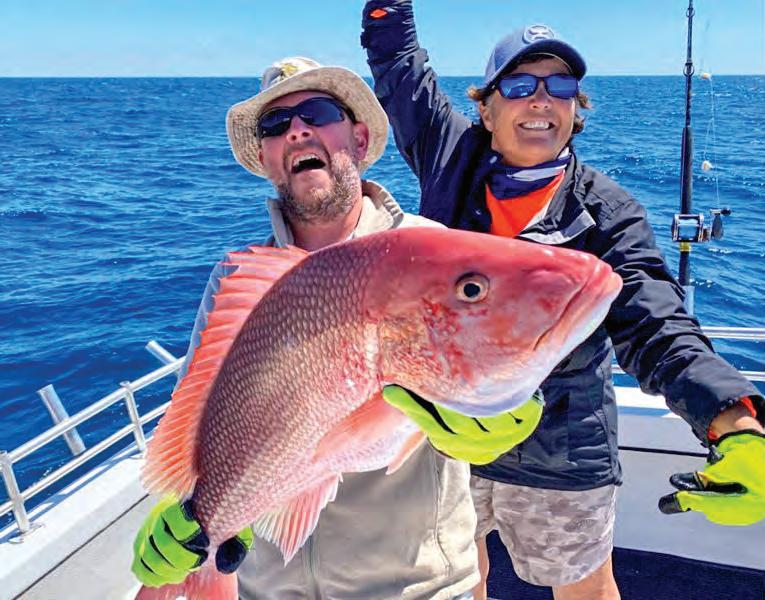
According to NOAA Fisheries, the red snapper fshery is in a “recovery trap.” Abundant red snapper have led to increased incidental catches by anglers, and NOAA extrapolates that data into a formula for catch-and-release mortality. Basically, they’re telling us that there are so many red snapper that anglers are killing too many of them by catching and releasing them.
Te result is tighter regulations in an infexible system, where highly questionable data is used to shut down access to a public resource. We’re not even going into numerous occasions in recent years when NOAA has been forced to admit its data is shockingly fawed.
According to the American Sportfshing Association, work is underway to improve data collection for the South Atlantic red snapper fshery.
In the meantime, try not to get in a boat wreck during the one-day mad dash to catch your one red snapper from the Atlantic. Or you can just trailer your boat to the Gulf of Mexico, where the states fnally managed to bludgeon some sense into federal fsheries managers a few years ago.
For more information, go to coastalanglermag.com.














Not only are these hefty bars one full Troy ounce of real, .999 precious silver, they’re also beautiful, featuring the crisp image of a Morgan Silver Dollar struck onto the surface. That collectible image adds interest and makes these Silver Bars even more desirable. Minted in the U.S.A. from shimmering American silver, these one-ounce 99.9% fine silver bars are a great alternative to one-ounce silver coins or rounds. Plus, they offer great savings compared to other bullion options like one-ounce sovereign silver coins. Take advantage of our special offer for new customers only and save $10.00 off our regular prices.
What makes them iconic? The Morgan Silver Dollar is the legendary coin that built the Wild West. It exemplifies the American spirit like few other coins, and was created using silver mined from the famous Comstock Lode in Nevada. In fact, when travelers approached the mountains around the boomtown of Virginia City, Nevada in the 1850s, they were startled to see the hills shining in the sunlight like a mirror. A mirage caused by weary eyes?

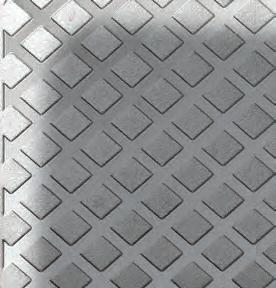



No, rather the effect came from tiny flecks of silver glinting in the sun.
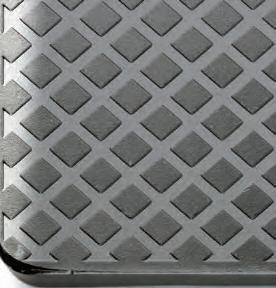





While no one can predict the future value of silver in an uncertain economy, many Americans are rushing to get their hands on as much silver as possible, putting it away for themselves and their loved ones. You’ll enjoy owning these Silver Bars. They’re tangible. They feel good when you hold them, You’ll relish the design and thinking about all it represents.
These Morgan Design One-Ounce Bars make appreciated gifts for birthdays, anniversaries and graduations, creating a legacy sure to be cherished for a lifetime.
Order More and SAVE
You can save $10.00 off our regular price when you buy now. There is a limit of 25 Bars per customer, which means with this special offer, you can save up to $250.
Hurry. Secure Yours Now! Call right now to secure your .999 fine silver Morgan Design One-Ounce Silver Bars. You’ll be glad you did.
One-Ounce Silver Morgan Design Bar
$49.95 ea.
Special ofer - $39.95 ea. +s/h
SAVE $10 - $250
Limit of 25 bars per customer

SHIPPING over $99!
time only. Product total over $99
Welcome to the best day of the week—the day before your next fshing trip! If you’re going ofshore tomorrow, it’s time to make a game plan, and a look at current Sea Surface Temperature (SST) charts is the frst step. With knowledge of accurate surface temps, chlorophyll imagery and other environmental factors, you can home in on areas that are likely to hold baitfsh and feeding predators.
By Mark Ambertto consider when targeting gamefsh. It provides shelter and feeding opportunities for all marine life. While you can stumble upon fsh just about anywhere in the ocean, you’ll locate more on and around structure.
Large underwater structure defects current and pushes nutrient-rich water toward the surface, creating areas where bait concentrates and holds. Also remember that weed lines are a key form of structure on the edges of the Gulf Stream.
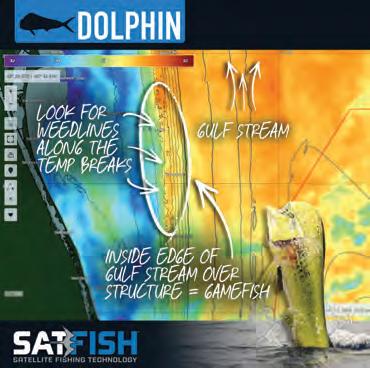
A reasonably priced satellite service is a small price to pay when compared to rising fuel prices and time spent running in search of gamefsh. Here are a few of the factors SST charts can help you decipher and improve the odds of fnding fsh.
Color Breaks: Te boundary areas between blue and green water, ofen referred to as color breaks, will typically stack up bait and hold above-average numbers of gamefsh.
Chlorophyll is the beginning of the food chain for marine life. Find it and you have a good chance at locating bait and fsh. Temperature and chlorophyll breaks ofen correspond with color changes. So, once you’ve reviewed the images and located the general area of a color break, this becomes an area of interest.
Structure & Current: Structure is critical
If you can fnd a color change that corresponds with structure, this is where you want to begin fshing. If everything lines up, there’s a good chance upon arrival that you’ll see marine life including birds, porpoise, fying fsh and other bait. Tis doesn’t mean you won’t catch fsh in of-colored water, but there’s a much better chance you’ll fnd concentrations of bait in or around the edges of areas where green and blue water interact.
Tides from inlets also play a role in water clarity, creating rips and weed-line formation. Bait will concentrate along the edge, especially where this water pushes up against the waters of the Gulf Stream. Look for these demarcation lines on incoming and outgoing tides.
Learn to read these vital signs both on and of the water using charts. If you can consistently

fnd areas that hold bait, you’ll always have a shot at your quarry. You will have become a top predator!
Mark Ambert, IG @marksgonefshing_™
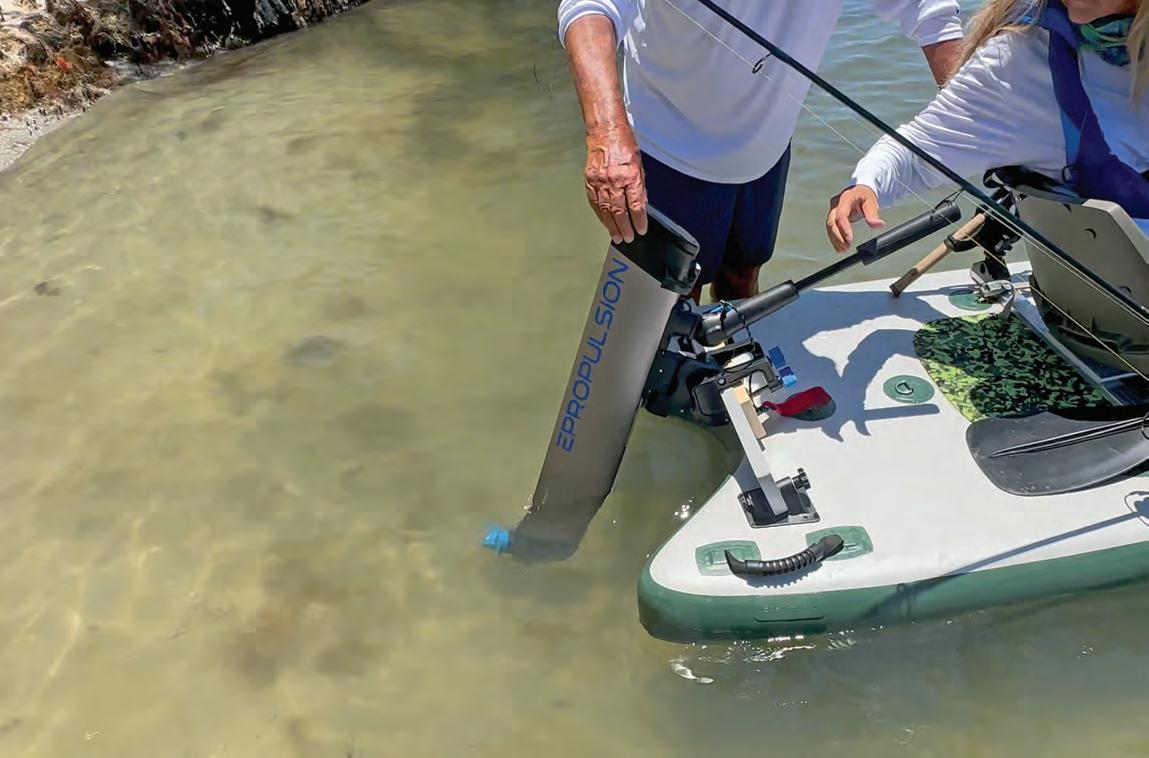
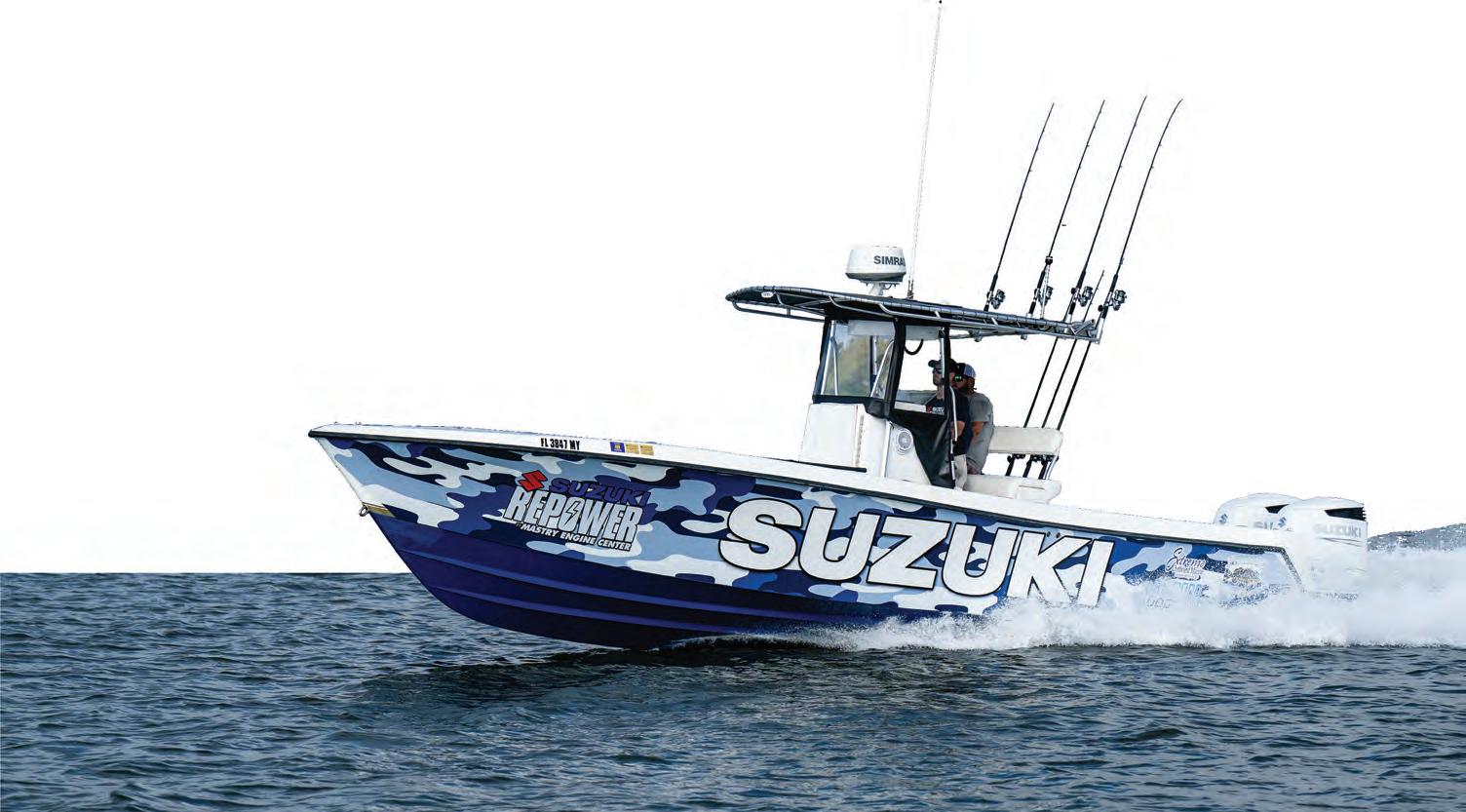










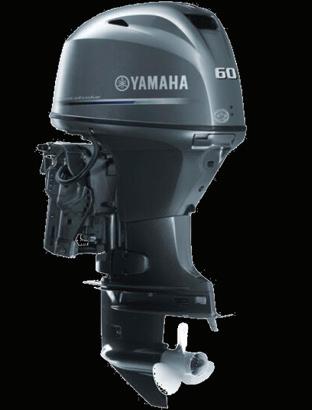




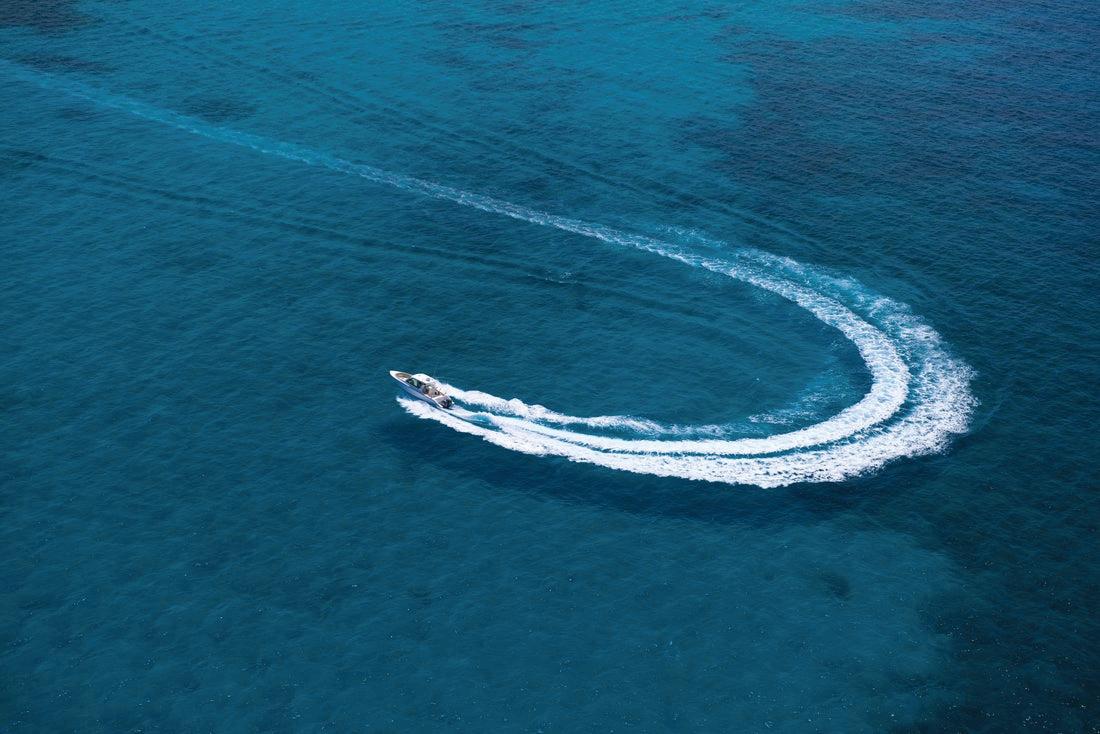
 By Mark Ambert
By Mark Ambert


The electric reel is a game changer for highspeed jigging. Electric provides some distinct advantages in comparison to hours spent manually cranking jigs at high speed through the water column.
With this style of jigging, I’m talking about working heavy jigs for big fsh on deep structure. Te key to catching fsh is fnding areas that consistently hold bait. Look for reefs, hills, and larger wrecks in deep water that hold baitfsh. Tis is where you’ll fnd feeding fsh.
Check your sonar screen frequently and look for “scratches” or fsh feeding in the water column. We usually assign one person to call out depth changes along with depth of marked fsh. Tuna can be found from 250 feet up to the surface. Highspeed cruisers like wahoo and kingfsh prefer the upper 50 feet of water, while amberjack will be close to structure. Jigging and adjusting depth to target fsh is more efcient under electric power, and the most difcult part of the electric game is picking the right equipment that works together.

Simplicity, along with reasonable size and weight, are key considerations for long days targeting big game fsh. I landed on the Piscifun Kraken X electric reel, and it has become indispensable in my arsenal.
Te Kraken is moderately priced and uses the same proven Japanese motor technology as many of its competitors. Te 33 pounds of max-drag were put to the test unexpectedly in the reel’s frst trip during a battle with the ultimate slugger—a 40-pound-class amberjack. Tey’re not called “reef donkeys” for nothing! Tis reel made short work of that AJ without heating up or momentarily shutting down, which is a common issue for overtaxed electric reels. I fsh a lef-handed model when high-speed jigging, and the Piscifun PB5000 battery pack provides all-day power and complete
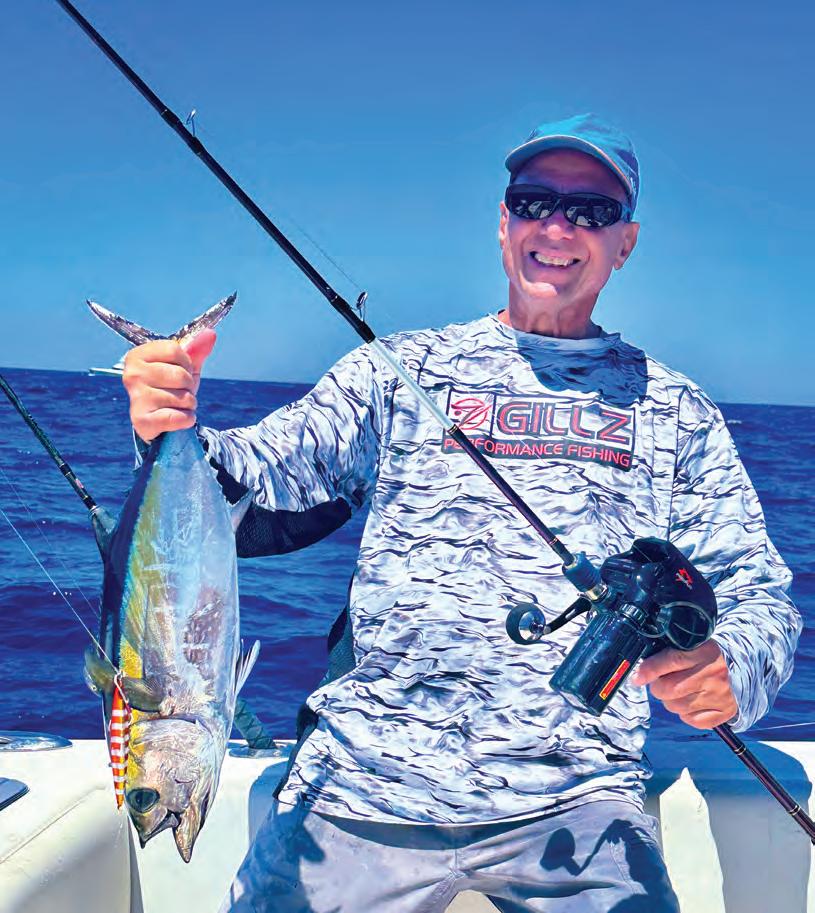
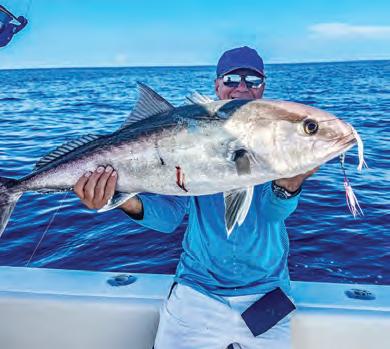
mobility around the boat.
Te Kraken mates perfectly with the Goofsh Monster Deep PE4-7. It’s a 7-foot rod that handles a maximum jig weight of 700g. It can deadlif 44 pounds, and has held up to some signifcant adversaries without being too heavy.
I spool all my reels with FINS braid. I use the 45/6, which has 45-lb. breaking strength and the diameter of 6-lb. monoflament. Tis matches the reel specifcations while adding line capacity. Te thin diameter also cuts through the water with little resistance, which is critical for vertical jigging.
On the business end, I use jigs in the 180-to320g range but can go as heavy as 700g if needed to reach bottom. I use a 50-lb. wind-on leader from Sufx. My go-to jigs are from Williamson, under the Rapala family of lures. Rapala also owns VMC,
so these lures are equipped with high-quality hardware. I use Koika, Kensaki, Vortex, Abyss and Benthos jigs.
With these in your arsenal, you can cover any situation and depth. Make sure to purchase glowin-the-dark options along with high visibility and natural colors. Purchase your favorites in multiple size ranges from light to heavy, and you’re set!

With an electric reel, you can easily alternate jigging retrieves from a slow yo-yo motion, which mimics a wounded baitfsh, to a full-on high-speed assault, which triggers the bite refex. Experiment with diferent techniques and settle on the one that works best on any given day.
Make sure the drag is set like any other star drag reel with the ability to pay out line when a big fsh slams your ofering. Once hooked up, use the electric motor to apply constant pressure. I fnd this is more efective for wearing a fsh down than manually pumping the rod while reeling.
Most of all, experiment with your new rig. It will open a world of new options and make your days much more enjoyable. I alternate between the powered setup and a quality spinning rod setup specifcally for jigging.
I personally have over 400 hours of hardcore jigging on this combination without a single point of failure. Now get one on the water and enjoy your new-found passion!
Mark Ambert, IG @marksgonefshing_™
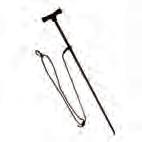


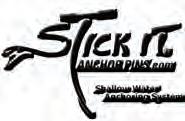
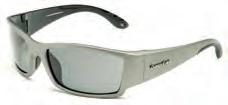




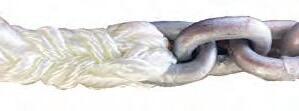

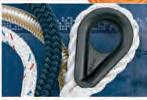




Just in case you missed the frst few runs of blackfn tuna that made it to south Florida, they’re still around, and this month I’d like to share some information and tips about targeting this amazing eating fsh.
Blackfn are very easy to distinguish from other tuna species. Like all tuna species, they are football shaped with smooth scales. Unlike yellowfn, blackfn do not have elongated dorsal or anal fns. Tey have a black stripe running along the top of their back. Most blackfn caught around here weigh between 5 and 10 pounds and measure in the 20- to 30-inch range.
Tese tuna are found from Massachusetts down into Brazil, including the Gulf of Mexico. Within these regions they will almost always be found in schools. Tese schools can be found in a variety of water depths which varies due to current and water conditions as well as the presence of baitfsh. However, they will typically not venture past 200 feet.

Since blackfns are highly migratory fsh and are constantly moving, they can’t exactly be targeted of reefs and other structures, like some other species. However, they do feed primarily on baitfsh and hunt prey like grunts, threadfns, blue runners or even pinfsh, and many times structure is what consolidates these baitfsh. Tuna schools can ofen be found wherever the bait schools are, and they tend to stick around for a while as they clear out all the baitfsh in an area. Tere are occasions when they will also eat squid or shrimp that foats past them.
Of Florida, blackfns spawn from April to September. When they spawn, the schools of blackfn move farther ofshore and participate in broadcast spawning. Te purpose of moving ofshore is to make sure that the eggs stay adrif in the Gulf Stream and don’t get pushed inshore. However, since the eggs and young tuna spend a majority of their life ofshore, this creates opportunities for predators such as mahi-mahi, skipjack tuna, sailfsh, birds, and of course sharks.
Tere are many ways to target blackfn tuna. I like to drif fsh for them with whatever bait is prevalent and available, whether it’s blue runners, sardines or threadfns. A typical spread for drifing might include two weighted downlines—one for the middle of the water column and one deeper— and a couple of freelines, one on each corner. Kites are another great way to present baits on the surface. With a spread like this, you’ll cover the water column from top to bottom and have a good chance of putting baits in a school of hungry blackfns. If you don’t love live bait, slow-pitch jigging around reefs is also an option. Either way, you never know what else you’ll catch while fshing for tuna.
Remember, fshing is called fshing and not catching for a reason. Try and try again until you succeed! Te IGFA all-tackle world record blackfn tuna weighed 49 lbs., 6-ozs. It was caught of Marathon, Florida back in 2006.
Emily Rose Hanzlik has caught more than 60 IGFA world records in various categories. Find her on
media @emilyhanzlikoutdoors.
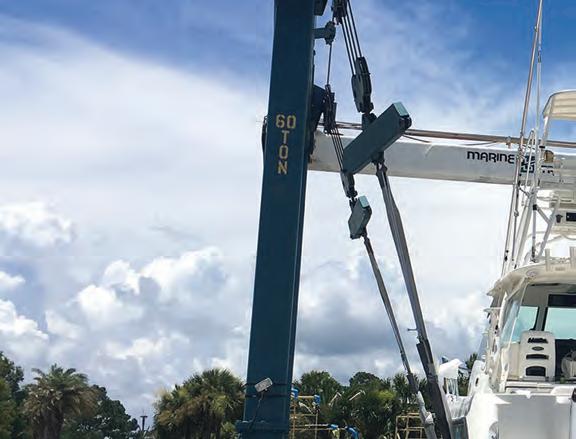









Whether considering repowering your trailer boat or your offshore beast, there is a Mastry Suzuki RePower Center that can serve your repower dreams. Mastry Suzuki RePower centers are the best in the business and have the experience, technical know-how and boating passion to make your repower project a remarkable success. With total boat systems capabilities your local Mastry Suzuki RePower Center can address all your upgrade aspirations. Essentially transforming your boat into a totally new boat at one single location.




















ShoreStation hydraulic boat lifts are a reliable choice for coastal residents and boating enthusiasts alike. Their strong construction, made with corrosion-resistant materials, allows them to withstand harsh environmental conditions, including sun, storms, and saltwater damage. ShoreStation provides a steadfast solution for protecting waterfront investments, ofering peace of mind to owners in the Sunshine State.
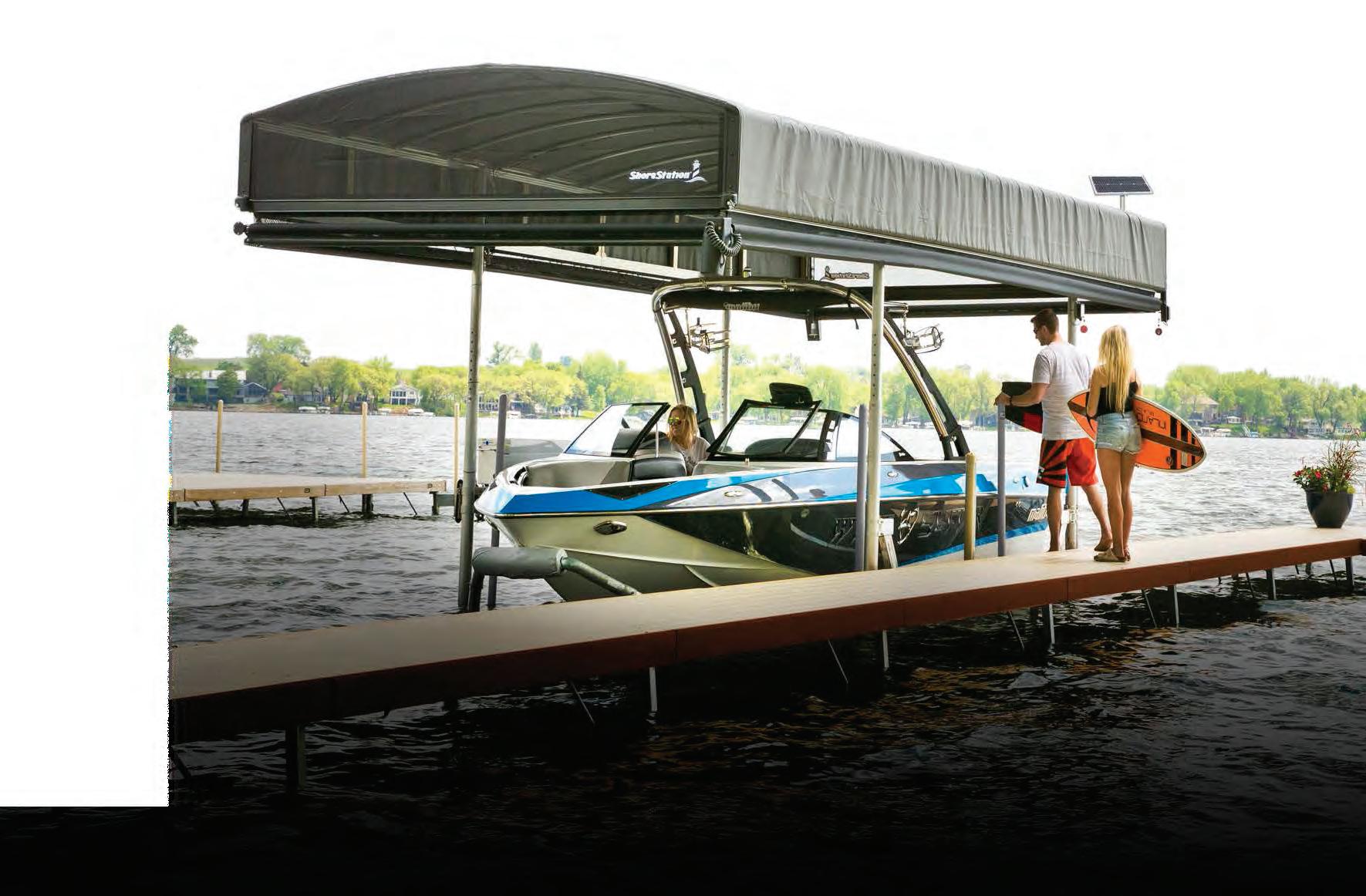
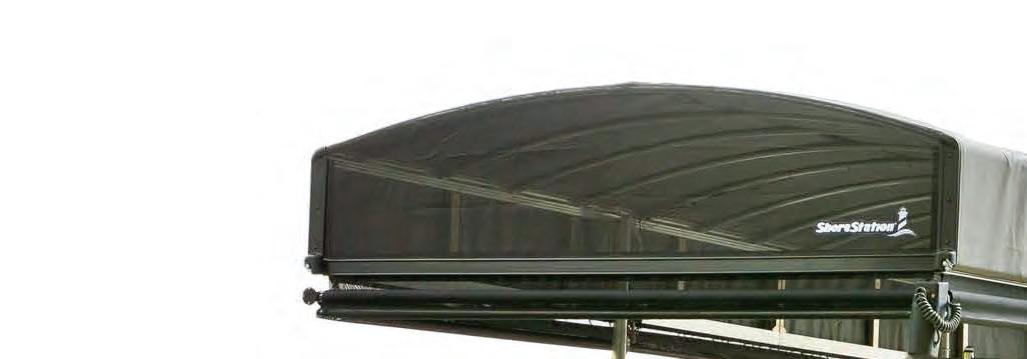
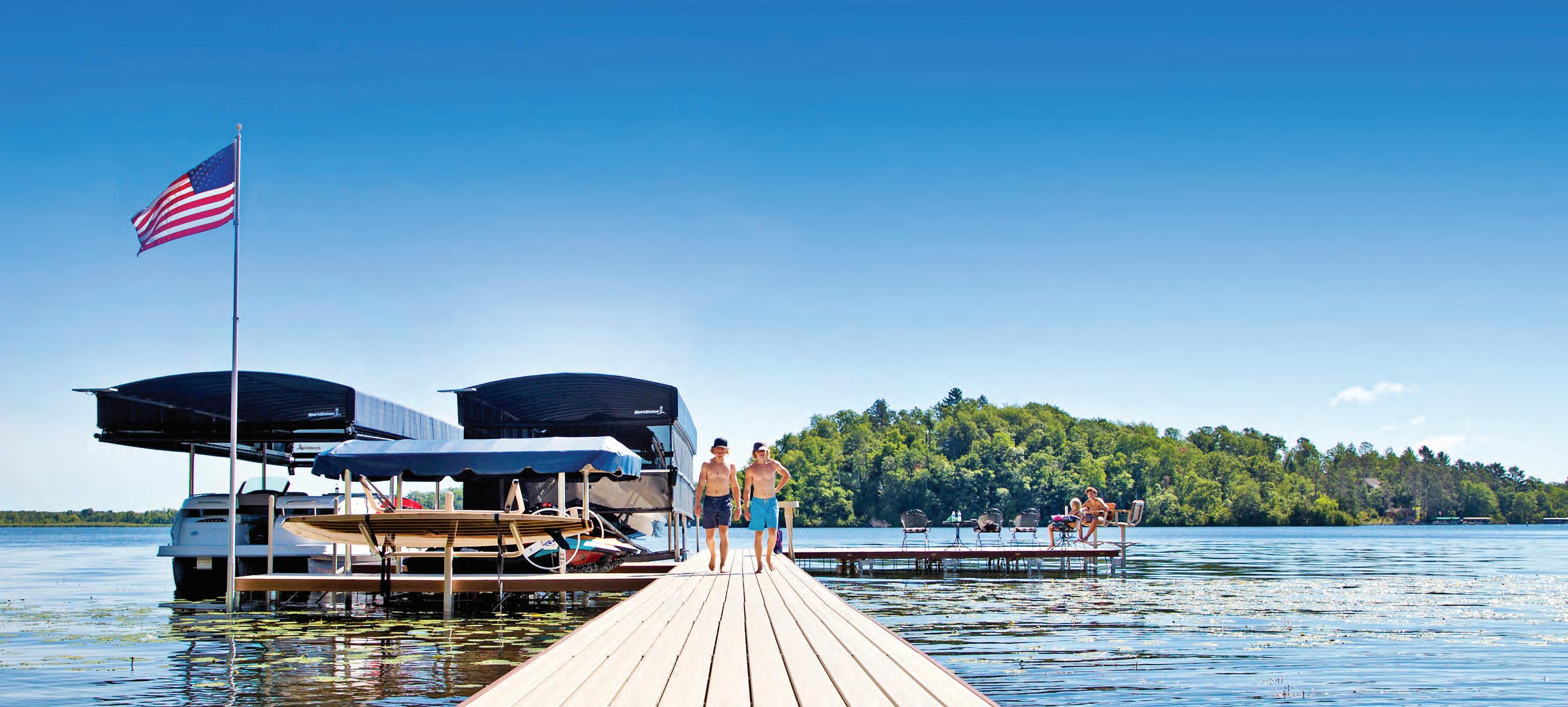
 No Profle Boat Lift
Four Piling Boat Lift
No Profle Boat Lift
Four Piling Boat Lift


Equipped with exceptional weather resistant fabric and breathable SunTex 80 woven mesh ends for maximum protection and durability,

Made from the highest quality materials, our innovative hydraulic boat lift is one of the fastest and safest lifts on the market today. When you have a hydraulic lift, there’s no need to worry about wind and waves getting in your way. This lift will give you confdence to safely land and secure your boat in less-than-ideal conditions.

Never miss another moment on the water. Power your lift with clean, free solar power. Our speedy 20 watt charger features solar regulator drainage protection, saving your battery from permanent damage caused by overcharging.



Every fsherman has a story of the “one that got away.” In my case, the “one that got away” story is of an ongoing battle that became personal.
One fall morning in central eastern Florida, I was fshing under a dock with a Zara Spook. During my retrieve, an explosion broke the water in a way I had never seen in 35 years of fshing. I stood in shock as line peeled of my 4000-size Penn Battle II combo. When the fsh jumped, I saw it was in the mid-40-inch range, and as is frequently the case with big snook, she played with me for a while before bolting into the pilings to break me of. Tis monster would have been my personal-best.
A few weeks passed before I returned to the same dock. Tis time I went armed with a paddletail. Maybe 15 casts in, she bit. I could tell right away it was the same fsh because of the way it fought and because it hit in the exact same location. Speaking of the same, she did the same thing and broke me of in the pilings.
Would you believe me if I told you it happened again? Well, you better, because it happened six more times! Afer the fourth break-of, as I was walking along the shore, I found the Spook I lost the frst time I hooked the fsh.
I told you it became personal. Over the next
four months, I woke up at 4:30 a.m. fve or six days a week to fsh the same spot.
By Brian DapeloI ended up having a total of seven hook-ups and break-ofs with that fsh before I went back to the drawing board.
I geared up to a Penn Battle II 5000 rigged with 30-pound braid and a 50-pound mono leader. I changed lures to a Zman MinnowZ pinned to a ¼-ounce DOA red long-shank jighead. My logic was the long shank would give space between the hook point and the leader, which kept getting frayed by the fsh’s teeth or sliced by the gill plate.
On the morning of Aug. 11, on the third cast of the day at the same spot, my lure just stopped. As I came tight, I saw the head of a snook. As it got closer, it kept getting bigger, and when I gave my rod a hard tug, the fsh didn’t even fght. It swam straight to the shoreline. I knew right away it was THE ONE! I worked quickly to measure and photograph
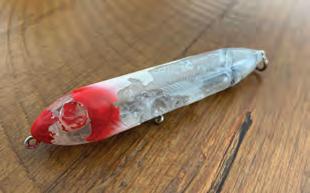

the fsh so I could release it safely. It was 44 inches, without the tail squeezed.
We all have stories of the ones that got away. How many can say they’ve had the same fsh get away seven times, only to land it eight months later in the same spot?
Got a great fshing story? Write it up and send it with a few photos to editorial@coastalanglermagazine.com. We might just share it with the world.




JULY 16-19



Noon till 5pm 16th
Saturday, October 12th, 2024
Gumbo Wars is on the Move - new hosting location, West End Trading Co. on corner of 2nd Ave & Sanford Ave, Downtown Sanford Proceeds



Colton & Lauren all smiles with their 1st win of the season, they are the current points leaders for “Team of the Year”
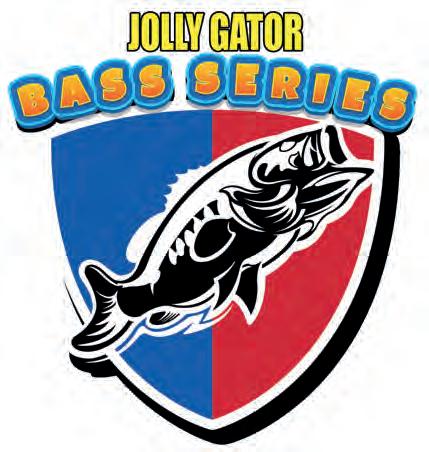
PRESENTING SPONSOR:
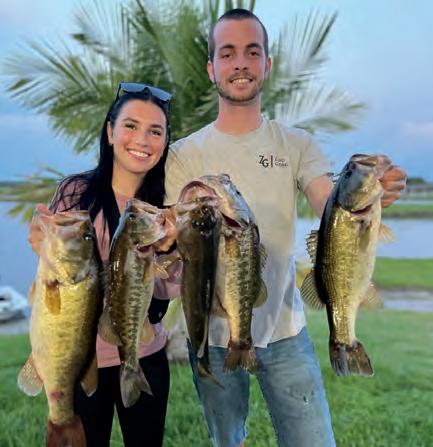
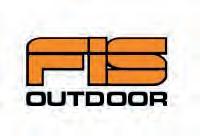




July
July
Tuesday 2nd, Tuesday 9th, Saturday 13th, Tuesday 16th, Tuesday 23rd, Tuesday 30th
Tuesday 2nd, Tuesday 9th, Saturday 13th, Tuesday 16th, Tuesday 23rd, Tuesday 30th
AUGUST
Tuesday 6th, CLASSIC Saturday 10th All Saturday events “Safe Daylight till 2pm”
ASSOCIATE SPONSOR:













Hot weather and hot water – very hot water temps. This means fish early morning, 4:30-7:30 AM, and late evening, or at night. Afternoon rains will lower the water temperature a couple degrees. This can trigger the bass to feed. When fish are busting baits (schooling bass) accurate casts of your top water bait is critical – cast quickly right in the spot where the fish strike occurred. Along the shoreline try stick baits, on the channel edges use a lipless crank bait or suspended slash bait. Don’t rule out these baits and have them tied on: flukes, trick worms, swim baits, Carolina rigged worms, creature baits and Texas rigged worms.
Bass: Cooler water temps in the morning entice bass to shallow ambush feeding areas; hydrilla edges and lily pads are their hiding places. Points along the river with running water cause bait to be flushed bringing in the schoolies for an evening
feed. The springtime panfish and shad hatchlings are now 2-3 inches. Try lures of same size: Rattle Traps (chrome), Rapala Countdown, small plastics etc. 4-inch soft plastics rigged on an eighth ounce weighted hook should produce quality fish along hydrilla edges. Flukes worked as finesse baits cast into the shallows are sure to get strikes. Bigger fish will destroy a stick bait - cast you’re bait literally inches from the edge of the shore - one or two twitches and hang on!
Panfish: The spawn is finished. The best bet is to fish channel edges and deeper water. Red wigglers and crickets with a small split shot holding the bottom will find the bluegill and stumpknockers for your frying pan.
Catfish: Cooler temperatures occur after the rains or at night. Both make catfish hungry. Circle hooks are great for catfish - the fish hook themselves and most times the hook ends up in the corner of the mouth making hook removal easier for these spiny fish. Tip: use just enough weight to hold the bottom and tie the weight 10 inches from the hook.


July brings this summer’s hottest days. Thankfully the late June rains brought our lake levels back up to give the fish better access to the heavy cover they love during the summer months. The afternoon rain-storms produce running water, so find some current and usually the bait and bass are close by. July is not only a hot month in temperature, but in bass fishing as well. If you love to catch them flipping, now is the best time of year to catch a giant bass in heavy cover. Pitching small profile soft plastic creature baits such as the Zoom U Vibe Speed Craw or the Gambler BB Cricket at the base of cattails, flat lily pad pockets, deep edges of Kissimmee grass, matted vegetation or shaded docks will usually produce a bite in the hottest parts of day. Wind blow backs will also produce current and produce oxygen rich areas cooling
the water temps just a degree or two. What is best is big fish tend to group up this time of year, so when you catch one slow way down and work the area thoroughly. Try night fishing to beat the heat, fish nights close to the full moon for the best results. Early morning gray skies or late evening have been producing better than average bites. Try fishing dense cover using a frog type bait or a swim-jig with a boot type trailer. Keep a look-out for schooling fish, have a top popper, spook type bait or rattle trap tied on to throw at these aggressive eaters. Cast to the middle of the school and fish your bait back very fast. Later in the day deep water grass edges and the old river channels in both Lake Harris and Little Lake Harris are good areas with brush-piles and man-made fish attractors. Find the eel grass or offshore hydrilla near hard bottom in Lake Dora or Lake Beauclair and throw large deep running crank baits, soft plastic swim baits or the old stand-by Carolina rig to produce bites from bigger fish. Find the bait and you will find the bass.


Preventative Maintenance • Complete Rebuilds All Trailer Types Serviced
Marine Grade Stainless Steel Parts Custom Axles • Accessories Large Parts Inventory For All Trailer Types. SALES
We Have Aluminum Boat, Pontoon, PWC Trailers Available as well as Utility, Equipment, Dump And Enclosed Trailers.

The 2024 Atlantic hurricane season could be one of the most active on record. It’s important that boaters have a plan in place for their vessel long before a storm is even named. Here’s a list of boating tips to consider before, during and after a hurricane.
General Preparedness Prior to a Storm
• Know what your marine insurance policy covers. Some insurance companies may require owners to pull their vessel out of the water during a storm or store it in a specific location while the storm is a threat.
• Understand your policy coverage as it relates to the recovery of your vessel, transportation or storage, repairs or, in the worst-case scenario, the demolition and disposal of your vessel.
• If your boat is kept at a marina, check your marina policy to understand requirements and procedures.
Before a Storm
• When a storm is approaching, determine where your boat will ride out the storm.


• If your boat needs to be relocated on land, position it on a trailer close to a strong building to break the wind and away from debris and strap it down securely. To anchor the trailer, place blocks beneath it and deflate the tires so it doesn’t shift around due to high winds.
• If the boat must stay in the water, secure it to the dock with longer, thicker lines to ensure it doesn’t sway during the storm.
• Ensure there aren’t any loose items on the boat that could potentially fly around during the storm and cause more damage.
• Take video inventory of all property onboard and place legal documents such as policies, licenses, and registration in a secure, dry place away from the vessel.
During a Storm
• Monitor radio, TV, NOAA Weather Radio, and/or hurricane
• hotline telephone numbers for official storm updates.
• Do not return to the vessel until there is an official announcement that the storm has passed, or the marina is open.
After a Storm
• Once it is safe to return to the vessel, inspect it for any structural damage.
• If the boat was damaged, take photos, and report it to your insurance company as soon as possible.
• Be sure to only work with licensed and insured companies, like Sea Tow, to recover your vessel. Rest assured knowing that Sea Tow’s experienced captains are available to assist with the recovery process and prevent any further damage.

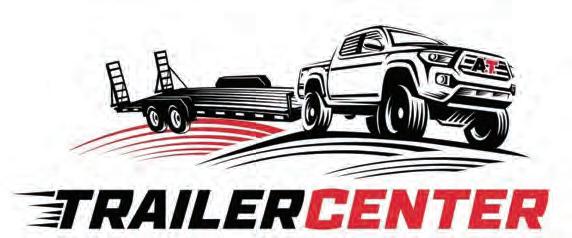



1 - Astor Marine (352) 759-3655 24535 FL-40, Astor, FL 32102 www.astormarine.com
2 - Nobles Marine (352) 787-5792 437 N Palmetto St, Leesburg, FL 34748 or 1931 N. Hwy 19, Crystal River www.noblesmarine.com
3 - Craig Catamaran (407) 290-8778 4333 Silver Star Rd. #100 Orlando, FL 32808
4 - Triangle Marine (352) 343-6146 11415 US-441, Tavares, FL 32778 www.trianglemarinecenter.biz
30 - Aamco East Orlando (407) 277-3311 6304 E. Colonial Dr. Orlando FL 32807 Full Service Mechanics
25 - Central Florida Marine (407) 647-6262 1021 N Orlando Ave, Maitland, FL 32751 www.centralfloridamarine.com
38 - Orlando Boat Sales (407) 253-7111 3165 N John Young Pkwy, Orlando, FL 32804 www.orlandoboatsales.com
24 - Boat Max USA (321) 866-0306 9700 E. Colonial Drive, Orlando FL 32817 www.boatmaxusa.com
46 - Gibson Truck World (407) 321-0660 3455 S. Orlando Dr. Sanford, FL 32773 www.gibsontruckworld.com
14 - Boat Tree Marina (407) 322-1610 4370 Carraway Pl, Sanford, FL 32771 www.boattree.com
60 - Next Level Inc.“Florida Marine Customs” (407) 704-5676 • 87 W. Michigan St. Orlando, FL 32806 info@floridamarinecustoms.com
Boat improvement / Service & Repair Centers / Replacement Parts
36 - All American Marine (407) 855-9988 7024 S Orange Ave, Orlando FL 32809 www.allamericanmarineorlando.com
35 - All Star Marine (407) 423-9953 28 W Jersey St, Orlando, FL 32806 www.manta.com
29 - Lake Fairview Marina (407) 295-0117 4503 N Orange Blossom Trail, Orlando, FL 32804 www. Lakefairviewmarina.com
32 - Portside Marine (407) 249-1124 2730 Forsyth Rd, Orlando, FL 32792 www.portsideorlando.com
23 - Talon Marine Services (407) 542-7600 439 Aulin Ave, Oviedo, FL 32765 www.talonmarineservices.com
6 - Sea Tow of Central Florida Lakes (877) 800-1492 12307 Wedgefield Drive , Grand Island, FL 32735
9 - Instant Insurance Agency (352) 735-5560 25833 State Road 46, Sorrento, FL 32776 www.instantinsuranceagency.com
Bait & Tackle Shops / Outfitters / Apparel
15 - American Tackle Co. (800) 516-1750 2133 Component Loop, Suite 1031, Oveido, 32765 www.americantackle.us
5 - Lakeside Bait & Tackle (352) 742-3336 1000 W Burleigh Blvd, Tavares, FL 32778
7 - Owens Fishing & Marine (352) 357-3030 935 N Bay St, Eustis, FL 32726
11 - Highbanks Marina & Camp Resort (386) 668-4491 488 W Highbanks Rd, DeBary, FL 32713 www.campresort.com
14 - Boat Tree Marina (407) 322-1610 4370 Carraway Pl, Sanford, FL 32771 www.boattree.com
21 - Bitters Bait & Tackle (407) 699-6619 65 N US Hwy 17 92, Longwood, FL 32750 www.bittersbaitandtackle.com
43 - Academy Sports + Outdoors East Colonial 11955 E. Colonial Dr Orlando, FL Lee Vista 6640 Eagle Watch Drive Orlando, FL Millenia 3557 Gardens Ridge Way Orlando, FL Lake Mary 3641 Lake Emaa Road Lake Mary FL
45 - Wojo’s Bait & Tackle (407) 891-1003 Oak Park Center, 4245 13th St, St Cloud, FL 34769
48 - Mud Hole Custom Tackle, Inc. (407) 447-7637 2133 Componet Loop Suite 1001, Oveido, FL 32765 www.mudhole.com
56 - Orlando Outfitters (407) 896-8220 2814 Corrine Dr., Orlando, FL 32803 www.orlandooutfitters.com
Home Improvement Contractors & Service Providers
26 - DWR Plumbing LLC. (407) 293-3717 6344 All American Blvd, Orlando, FL 32810
27 - Orlando Painting Service (407) 896-0839
65 Harold Ave, suite B, Winter Park, FL 32789 www.orlandopaintingservice.com
28 - Millennium Electric (407) 420-2001 4340 Edgewater Dr, Orlando, FL 32804 www.millennium-electric.com
41 - Water Works Pressure Cleaning & Sealing (407) 376-9526
490 Buck Lake Lane, Geneva, FL 32732 www.jmwaterworksinc.com
20 - Team Marine Services (407) 260-8326 1350 28th Street, Orlando FL 32805 www.teammarineservices.com
19 - Ahoy Marine (407) 323-8373 511 E 25th St, Sanford, FL 32771 www.superpages.com

31 - Pyramid Cabinets (407) 947-8499 451 Fairvilla Road, Orlando, FL 32808 www.codepyramid.com
31 - Pyramid Cabinets (407) 947-8499
451 Fairvilla Road, Orlando, FL 32808 www.codepyramid.com
34 - Thomas Lumber Company (407) 841-1250
34 - Thomas Lumber Company (407) 841-1250
231 W Gore St, Orlando, FL 32806, www.thomaslumber.com
231 W Gore St, Orlando, FL 32806, www.thomaslumber.com
49 - Martin Tree Service, Inc. (407) 359-1119 1215 Bob White Trail, Chuluota, FL 32766 www.martintreeserviceinc.com
49 - Martin Tree Service, Inc. (407) 359-1119 1215 Bob White Trail, Chuluota, FL 32766 www.martintreeserviceinc.com
50 - Campbell Renovations Inc. (407) 947-0016 285 Campbell Ranch Run, Geneva, FL 32732 www.campbellrenovationsinc.com
50 - Campbell Renovations Inc. (407) 947-0016 285 Campbell Ranch Run, Geneva, FL 32732 www.campbellrenovationsinc.com
51 - Vapor and Company (407) 878-7397 3621 S. Orlando Dr., Sanford, FL 32773 SR 436 Altamonte Springs East SR 50 Orlando www.vaporandco.com
51 - Vapor and Company (407) 878-7397 3621 S. Orlando Dr., Sanford, FL 32773
SR 436 Altamonte Springs East SR 50 Orlando www.vaporandco.com
Areas Best Picks for Restaurants
Areas Best Picks for Restaurants
47 - Jolly Gator Fish Camp Bar & Grill (407) 349-5554
47 - Jolly Gator Fish Camp Bar & Grill (407) 349-5554
4650 E State Rd 46, Geneva, FL 32732 www.thejollygator.com
4650 E State Rd 46, Geneva, FL 32732 www.thejollygator.com
39 - Fish on Fire (407) 812-6881 7937 Daetwyler Dr, Orlando, FL 32812 www.fishonfireorlando.com
39 - Fish on Fire (407) 812-6881 7937 Daetwyler Dr, Orlando, FL 32812 www.fishonfireorlando.com
40 - High Tide Harry’s (407) 273-4422 4645 S Semoran Blvd, Orlando, FL 32822 www.hightideharrys.com
40 - High Tide Harry’s (407) 273-4422 4645 S Semoran Blvd, Orlando, FL 32822 www.hightideharrys.com
33 - Boston’s Fish House (407) 678-2107 Aloma Square Shopping Center, 6860 Aloma Ave, Winter Park, FL 32792 www.bostonsfishhouse.com
33 - Boston’s Fish House (407) 678-2107 Aloma Square Shopping Center, 6860 Aloma Ave, Winter Park, FL 32792 www.bostonsfishhouse.com
17 - St. Johns River Steak & Seafood (407) 878-0980
17 - St. Johns River Steak & Seafood (407) 878-0980
550 N Palmetto Ave, Sanford, FL 32771
550 N Palmetto Ave, Sanford, FL 32771
37 - The Steer (407) 286-6802 8015 S. Orange Ave., Orlando FL
37 - The Steer (407) 286-6802 8015 S. Orange Ave., Orlando FL
22 - Huey Magoo’s (407) 706-6004 www.hueymagoos.com
22 - Huey Magoo’s (407) 706-6004 www.hueymagoos.com
10 Locations – See our ad on Restaurant Page
10 Locations – See our ad on Restaurant Page
13 - Camp House Restaurant (407) 915-5401
13 - Camp House Restaurant (407) 915-5401
100 S White Cedar Rd, Sanford, FL 32771 www.camphousebarandgrill.com
100 S White Cedar Rd, Sanford, FL 32771 www.camphousebarandgrill.com
52 - The Deli (407) 332-8800 4360 Carraway Pl, Sanford, FL 32771
52 - The Deli (407) 332-8800 4360 Carraway Pl, Sanford, FL 32771
53 - T J’s Seafood Shack (407) 365-3365
53 - T J’s Seafood Shack (407) 365-3365
197 E Mitchell Hammock Rd, Oviedo, FL 32765 12231 E Colonial Dr. #230, Orlando(407) 250-4191 www.tjsseafoodshack.com
197 E Mitchell Hammock Rd, Oviedo, FL 32765 12231 E Colonial Dr. #230, Orlando(407) 250-4191 www.tjsseafoodshack.com
54 - Oasis On The River (407) 636-6300 4380 Carraway Place, Sanford, FL 32771
54 - Oasis On The River (407) 636-6300 4380 Carraway Place, Sanford, FL 32771
56 - Celery City Craft (407) 915-5541 114 S. Palmetto Ave., Sanford FL 32771 celerycitycraft.com
56 - Celery City Craft (407) 915-5541 114 S. Palmetto Ave., Sanford FL 32771 celerycitycraft.com
55 -West End Trading Co. (407) 322-7475
202 Sanford Ave, Sanford, FL 32771 www.drinkatwestend.com
55 -West End Trading Co. (407) 322-7475 202 Sanford Ave, Sanford, FL 32771 www.drinkatwestend.com



Sea Tow of Central Florida Lakes (877)800-1492
12307 Wedgefield Drive , Grand Island, FL 32735
Always Looking for Captains
Lake, Orange, Western Volusia, Seminole, Osceola, Western Brevard, Eastern Sumter, Eastern Polk
All American Marine 7024 S Orange Ave, Orlando, FL 32809
Phone: (407) 855-9988 www.allamericanmarineorlando.com
Service All Outboard Brands – Stern Drives –Canvas – Interiors – Trailer Repair
Lake Fairview Marina 4503 N Orange Blossom Trail, Orlando, FL 32804
Phone: (407) 295-0117 www. Lakefairviewmarina.com
Triangle Marine 11415 US-441, Tavares, FL 32778
Phone:(352) 343-6146 www.trianglemarinecenter.biz
Bennington Pontoons – TideWater Johnson – Evinrude – Yamaha
Boat Max USA 9700 E. Colonial Drive, Orlando FL 32817
Phone: (321) 866-0306 www.boatmaxusa.com
Pioneer - Glasstream - Aquasport - Stottcraft New Boats Sales - Authorized Yamaha and Suzuki Dealer Parts and Service
Consignment Sales – Outboard Service –Storage – Ship Store – Sailing Classes Thomas Lumber Company 231 W Gore St, Orlando, FL 32806, Phone: (407) 841-1250 www.thomaslumber.com
Nobles Marine
437 N Palmetto St, Leesburg, FL 34748 or 1931 N. Hwy 19, Crystal River Phone: (352) 787-5792 www.noblesmarine.com
Mako – Tracker – Nitro – Tahoe - Mercury Regency - Sun Tracker
Owens Fishing & Marine
935 N Bay St, Eustis, FL 32726 Phone: (352) 357-3030
Saltwater Tackle & Bait - Ballyhoo, Freshwater Tackle - Live Bait - Wild Shiners
Costa - Shimano Top Shelf Dealer
Outboard Service & Boat Parts
Hunting & Snorkeling Accessories Bow Fishing
St. Johns River Steak & Seafood 550 N Palmetto Ave, Sanford, FL 32771
Phone: (407) 878-0980
On Water Location – Special Events – Full Bar – Steaks – Fresh Seafoodel
Old Fashion Lumber Yard – Lumber – Trim –Custom Doors – Hardware – Delivery –Customer Service Orlando Painting Service 65 Harold Ave, suite B, Winter Park, FL 32789 Phone: 407) 896-0839




Summer is definitely here, and the fish know it. The Kissimmee chain is at low pool and the lakes are slowly filling up due to the summer showers. The Bass bite has been good early morning and late evening. Goblets Cove has been really good. Try and beat the heat, the bass like shade too. Most bass are being caught out in open water vegetation along hydrilla ledges. On West Lake Toho most anglers are using plastics, I have been throwing a June bug or pink trick worm, no weight, working it over vegetation and waiting for that explosive hit. Also try using a Carolina rig with a 1 oz. weight to get through the vegetation. Folks are having good success trolling live wild shiners up and down the hydrilla patches. East Lake
Toho is still one of the better artificial lakes to fish in during the summer. Along the northwest shore fish try fishing open water peppergrass. You should try a zoom vibe magnum worm, Texas rigged. Swimbaits are another good choice. Gambler EZ Swimmer on a weighted hook in the Copperfield color likely will get bit.
Panfish: Bluegills are spawning in the canals and any place that is sandy and any type of flow near it - bait of choice is crickets. Popping bugs also work well this time of year. Shell crackers are in very shallow water spawning; this info was tipped off by accident running the airboat up skinny. The best bait for the shell cracker is red wigglers. Both can be caught with cane poles or light tackle. Catfish as bycatch is a good thing, try using 8-pound test – it will hold a pretty good sized cat and still be thin enough that the panfish don’t see it. Watch for the afternoon storms and be safe!


Lake Okeechobee water levels have been slowly coming down to low levels - use extreme caution running your boat especially when getting on/off plane. With levels getting lower, it’s a great time to fish the canal system and Kissimmee River for bass, bream and crappie around the river pilings early mornings. You’ll find the bream beds along the river’s edge with bass feeding on them. When river fishing for bass, use deep diving crank baits around ledges and drop-offs in colors crawdad; shad and bream and Carolina rigs rigged with creature-style baits; big worms; senkos and flukes in colors Junebug; red bug; black/blue; white and tilapia.
Start early in the morning and get 6 hours of fishing in before the heat of midday and before afternoon t-storms. If you’re fishing the lake for bass and bream, an area that’s produced steady bites
has been around Tin House and Kings Bar, launching from Scott Driver or Okeetantie ramp on the Kissimmee River. If you’re coming from the West, launch at Harney Pond canal but be sure to stop by Big Water Bait & Tackle for all your tackle needs before heading out to fish Dyess Ditch, Monkey Box and Horse Island. Some areas in/around the Shoal have been producing bass and bream bites around the grassy/maiden cane areas. Remember, this is a good time of year to fish deeper water areas and avoid running the lake and possible lower unit issues if you’re unsure.
To book you’re next fun and educational day fishing Lake Okeechobee call Capt. Angie at 863-228-7263 or visit www.southfloridabassfishing.com where you’ll find up-to-date customer pics and their catches; past fishing reports; pricing etc. Deposits for the upcoming season are available, book early to get your preferred dates. Capt. Angie’s sponsors: Toho Marine; Gill; Bullet Weights; BnM Poles; Mercury; G-Loomis; Lews; Pradco Brands; Gene Larew; Mid South Tackle and Megastrike.

popping bug. I have thoroughly enjoyed hearing the popping bug get hit. Daytime anglers are catching good numbers fishing the shallow bedding areas. Bait of choice is crickets fished under a float.Another good area to fish is canals when the water is flowing, trolling will only trigger more bites. Crappie - Anglers are fishing open water for crappie using jigs tipped Anglers trolling jigs are catching good limits of crappie. The key is to find them
popping bug. I have thoroughly enjoyed hearing the popping bug get hit. Daytime anglers are catching good numbers fishing the shallow bedding areas. Bait of choice is crickets fished under a float.Another good area to fish is canals when the water is flowing, trolling will only trigger more bites. Crappie - Anglers are fishing open water for crappie using jigs tipped Anglers trolling jigs are catching good limits of crappie. The key is to find them

East Lake Toho - Bass fishing on East Lake has been good using artificial baits early morning. The best place to fish will be at the edges of the cattails. Then move to open water as the morning progresses. Most anglers are flipping open water pepper grass matts with good success. Fish the deeper edges of the grasswatermelon seed, Junebug, and
East Lake Toho - Bass fishing on East Lake has been good using artificial baits early morning. The best place to fish will be at the edges of the cattails. Then move to open water as the morning progresses. Most anglers are flipping open water pepper grass matts with good success. Fish the deeper edges of the grasswatermelon seed, Junebug, and

at nighttime in the canals using a fly rod, throwing popping bugs up against the bank. On a good moon phase, the bluegill will crush the
at nighttime in the canals using a fly rod, throwing popping bugs up against the bank. On a good moon phase, the bluegill will crush the
Panfish - Fish open water shell beds with red wigglers. If you are looking to fill the cooler for dinner, the open water shell beds are hard to beat.
Panfish - Fish open water shell beds with red wigglers. If you are looking to fill the cooler for dinner, the open water shell beds are hard to beat.
bass trips which are typical for this time of year. The month of September is when to start thinking of booking your bass fishing trip, as the females start to feed up while they make their way into the shallows for the early spawn time. It’s also the time to book your fall crappie trip too. Good fishing areas: parts of the shoal; Dupree Bar; Dyess ditch and Horse Island and Indian Prairie. Tin house has been solid throughout the season for crappie, bass and bream, work your way up towards 3rd and 2nd point where you’ll find some bass feeding on the bedding bream. A few areas on Kings Bar have been good and
bass trips which are typical for this time of year. The month of September is when to start thinking of booking your bass fishing trip, as the females start to feed up while they make their way into the shallows for the early spawn time. It’s also the time to book your fall crappie trip too. Good fishing areas: parts of the shoal; Dupree Bar; Dyess ditch and Horse Island and Indian Prairie. Tin house has been solid throughout the season for crappie, bass and bream, work your way up towards 3rd and 2nd point where you’ll find some bass feeding on the bedding bream. A few areas on Kings Bar have been good and
To book you’re next fun-filled, productive and educational fishing trip call me at 863-228-7263 or log onto my website to check out the customers and their catches; hotel recommendations; guide rates and etc. Capt Angie’s sponsors are: Caymas boats and Toho
and Toho
To book you’re next fun-filled, productive and educational fishing trip call me at 863-228-7263 or log onto my website to check out the customers and their catches; hotel recommendations; guide rates and etc. Capt Angie’s sponsors are: Caymas
MidSouth Tackle; Maui Jim; Gill; Bullet Weights; Road Runner; Real Magic; Tru Turn hooks; Mega Strike; Gene Larew; Pradco Brands and BUFF
Maui Jim; Gill; Bullet Weights; Road Runner; Real Magic; Tru Turn hooks; Mega Strike; Gene Larew; Pradco Brands and BUFF

8:43 PM 2.52 H 5F 2:21 AM 0.17 L


6:20 PM 0.18 L
11TH 12:49 AM 2.21 H
1M 5:01 AM 2.24 H
11:08 AM -0.31 L
5:59 PM 2.42 H
11:42 PM 0.23 L
2TU 6:02 AM 2.24 H
12:04 PM -0.35 L
6:58 PM 2.46 H
3W 12:38 AM 0.21 L
7:00 AM 2.27 H
12:58 PM -0.37 L
7:53 PM 2.5 H
4TH 1:31 AM 0.19 L
7:55 AM 2.3 H
1:50 PM -0.37 L
8:43 PM 2.52 H
5F 2:21 AM 0.17 L
8:46 AM 2.32 H
2:39 PM -0.35 L
9:30 PM 2.51 H
6SA 3:09 AM 0.16 L
9:33 AM 2.32 H
3:26 PM -0.29 L
10:14 PM 2.49 H
7SU 3:55 AM 0.16 L
10:19 AM 2.29 H
4:11 PM -0.21 L
10:55 PM 2.44 H
8M 4:40 AM 0.17 L
11:02 AM 2.25 H
4:55 PM -0.09 L
11:34 PM 2.38 H
9TU 5:24 AM 0.19 L
11:45 AM 2.19 H
5:37 PM 0.04 L
10W 12:12 AM 2.3 H
6:07 AM 0.21 L
12:27 PM 2.13 H
6:20 PM 0.18 L
11TH 12:49 AM 2.21 H
6:50 AM 0.23 L
1:11 PM 2.06 H
7:04 PM 0.33 L
12F 1:26 AM 2.12 H
7:34 AM 0.26 L
1:56 PM 2.02 H
7:51 PM 0.45 L
13SA 2:06 AM 2.04 H
8:19 AM 0.27 L
2:45 PM 1.98 H
8:41 PM 0.55 L
14SU 2:49 AM 1.97 H
9:07 AM 0.27 L
3:38 PM 1.97 H
9:34 PM 0.6 L
15M 3:38 AM 1.92 H
9:58 AM 0.24 L
4:35 PM 2 H
10:29 PM 0.62 L
16TU 4:32 AM 1.91 H
10:49 AM 0.18 L
5:34 PM 2.06 H
11:23 PM 0.59 L
17W 5:31 AM 1.95 H
11:41 AM 0.08 L
6:32 PM 2.16 H
18TH 12:15 AM 0.52 L
6:29 AM 2.03 H
12:32 PM -0.04 L
7:26 PM 2.29 H
19F 1:05 AM 0.43 L
7:25 AM 2.15 H
1:21 PM -0.17 L
8:17 PM 2.43 H
20SA 1:53 AM 0.31 L
8:18 AM 2.28 H
2:10 PM -0.28 L
9:05 PM 2.56 H
21SU 2:41 AM 0.18 L
9:09 AM 2.41 H
2:58 PM -0.36 L
9:52 PM 2.67 H
22M 3:29 AM 0.05 L
10:00 AM 2.53 H
3:47 PM -0.38 L
10:37 PM 2.73 H
23TU 4:17 AM -0.07 L
SEBASTIAN INLET BRIDGE
10:51 AM 2.61 H
4:37 PM -0.34 L
11:22 PM 2.74 H
24W 5:07 AM -0.17 L
11:43 AM 2.65 H
SEBASTIAN (IRL)
5:28 PM -0.24 L
OFFSET
25TH 12:08 AM 2.71 H
5:58 AM -0.23 L
92 min / Low 156 min HEIGHT OFFSET
12:36 PM 2.64 H
6:21 PM -0.09 L
26F 12:55 AM 2.63 H
6:51 AM -0.24 L
1:31 PM 2.6 H
7:18 PM 0.07 L
27SA 1:45 AM 2.52 H
7:48 AM -0.22 L
2:30 PM 2.53 H
8:18 PM 0.23 L
28SU 2:39 AM 2.41 H
8:47 AM -0.17 L
3:32 PM 2.46 H
9:21 PM 0.36 L
29M 3:38 AM 2.31 H
9:49 AM -0.12 L
4:37 PM 2.41 H
10:25 PM 0.43 L
30TU 4:41 AM 2.26 H
10:51 AM -0.09 L
5:43 PM 2.39 H
11:26 PM 0.46 L
31W 5:46 AM 2.25 H
11:50 AM -0.08 L
6:44 PM 2.42 H

on calmer, hotter days with afternoon showers makes early morning fishing the best bet. The grass in the flats in Mosquito Lagoon and the Indian River is growing thicker and higher than it has in 5 years. The grass makes it difficult to use jigs, so change to weedless jerk baits, weedless spoons or topwater plugs. The grass will help out the future of fishing by creating an estuary for the young fish to hide.
Look for trout and redfish in the sand holes on the flats, they will ambush baits going through. The water usually gets a little dirtier as the summer goes on, but sight fishing should still be good. Try fishing around the dropoffs where the grass is not as high or in sandy spots along the edge of the shorelines. Most land points have sandy areas and if the wind is blowing into them that is a good spot to try using cut bait or live bait. With pinfish, mullet and ladyfish cut bait you can catch all species in the lagoon. Capt. Troy uses a 3/0 J hook and 25# mono leader tied to 8-15# braid.
Target docks south in the Indian and Banana River for trout, redfish, black drum and snook. They love to hangout under old and unused docks with shade where the grass does not grow very well. Work the area with gold spoons or Mission Fishing jigs with Wyze Guys paddle tails, preferably white or grey. Cut bait and shrimp works well for black drum, sheepshead and mangrove snapper. If there are rod holders, fishing rods and bait buckets, or a new dock, avoid fishing those docks. Nighttime fishing around the docks with lights can also be very productive and a good way to beat the heat. However, the bugs may be bad so bring spray.
Tarpon fishing in the ocean should be primetime and in the river for big tarpon should start to heat up. If sight fishing, look for them rolling on calm days in the ocean or the river. Fly fishing works very well. If bait fishing use the biggest mullet on the bottom with 60# fluorocarbon leader with 10/0 circle hook and 30# braid. The reason for the biggest mullet dead on the bottom is to avoid catching a sail cat in the river. Jigs or live mullet is best for sight fishing to keep the sail cats away. In the ocean you must worry about sharks. Capt. Troy’s tip of the month: July and August Troy fishes for tarpon more than any other species. Troy Perez
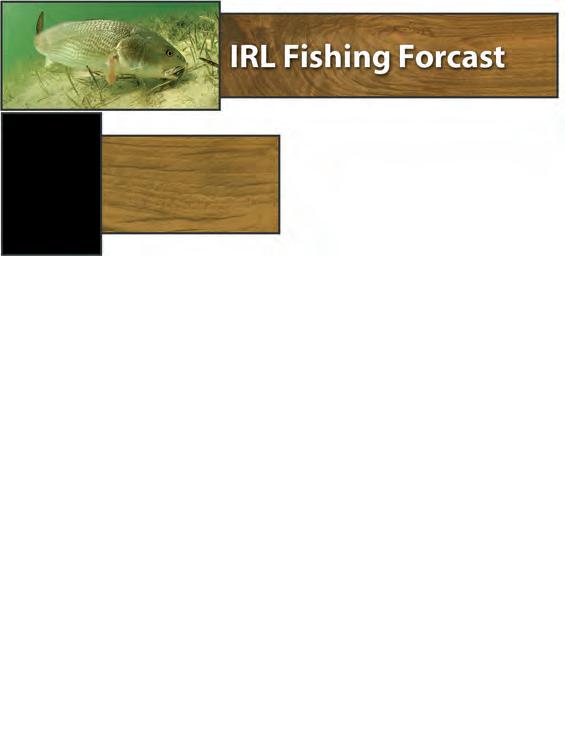

Target docks south in the Indian and Banana River for trout, redfish, black out under old and unused docks with shade where the grass does not grow very well. Work the area with gold spoons or Mission Fishing jigs with Wyze Guys paddle tails, preferably white or grey. Cut bait and shrimp
head and mangrove snapper. If there are rod holders, fishing rods and bait ing those docks. Nighttime fishing around the docks with lights can also be very productive and a good way to beat the heat. However, the bugs
Confessions of a Fishaholic, by Thatch Maguire, is a hilarious and irreverent look at one man’s quest to catch fish in spite of life’s annoying interferences. You’ll travel with this awkward adventurer as he risks home and health to pursue his passion for fishing...regardless of the consequences. Anglers of all expertise levels will immediately identify with why his addiction is incurable. This book defines the blurred line between passion and obsession.

Tarpon fishing in the ocean should be pon should start to heat up. If sight fishing, look for them rolling on calm days in the ocean or the river. Fly fishing works very well. If bait fishing use the biggest mullet on the bottom with 60# fluorocarbon leader with 10/0 circle hook and 30# braid. The reason for the biggest mullet dead on the bottom is to avoid catching a sail cat in the river. Jigs or live mullet is best for sight fishing to keep the sail cats away. In the ocean you must worry about sharks. Capt. Troy’s tip of the month: July and August Troy fishes for tarpon more than any other


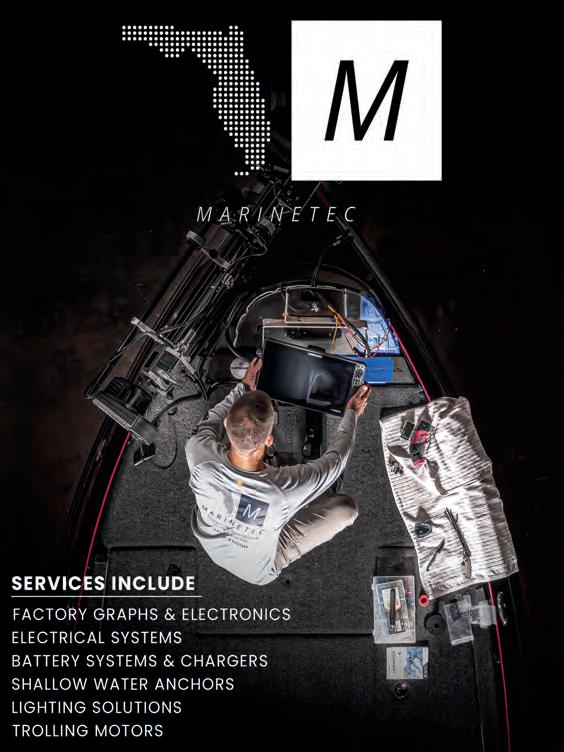
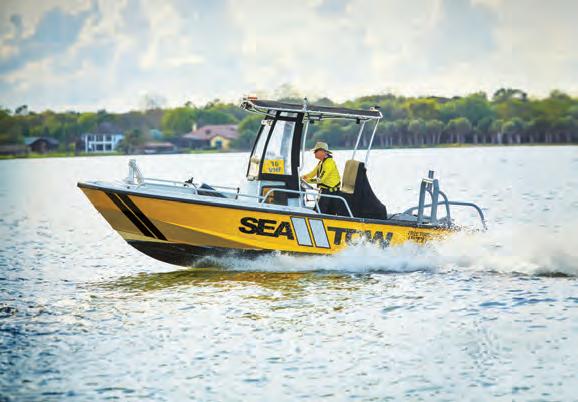

July 1st kicks off the 10-week Scallop season along Florida’s Nature Coast. It is good fun, a nice way to beat the summer heat and something the whole family can enjoy. And oh yes, the best part, preparing and eating them!
There was a time when most of Florida enjoyed scallop harvesting. I believe one of the main reasons it doesn’t now is because of coastal growth, development and population in other areas of the state which unfortunately brings with it, less habitat and sometimes lesser water quality. The legal Bay Scallop Zone is from the Pasco/ Hernando County line north to Mexico Bay Canal in Bay County.
Here are some guidelines to insure a happy trip out for the scallops. First off, it can be quite busy at the ramp, on the river, and out at the picking’ grounds. Please, please remember to be respectful, and cautious when navigating in and around these waters. And no B.W.I’s! Secondly, the season runs from July 1 through Sept. 25th. Third - the preliminary reports are very good. There are plenty of scallops for adequate collections this season.
Legal Requirements: If you’re between 16 and 65, you must have a current saltwater fishing license to harvest scallops. Unless you are fishing (scalloping) with a for-hire vessel – a guide, that has a valid vessel license. And you can check with your marina, but most of them don’t allow rental vessels to go as far out to where the scallop grounds are. Recreational harvesters are limited to 2 gallons of whole bay scallops in the shell, or 1 pint of scallop meat per person, per day. In addition, no more than 10 gallons of whole scallops or ½ gallon of meats may be possessed aboard any vessel at any time. A “diver’s down” flag (20”x24”) must be displayed from your boat when divers are in the water. Law enforcement is concerned about safety and doesn’t play, so don’t forget it, and display it.
A mask, snorkel, (fins optional) and a small diver’s mesh bag are all that’s needed. The reason I say fins optional is that most of the time you can find them in water shallow enough you do not need them. Plus, the fin wakes or propulsion can stir up the dust off the grass blades or mud bottom that can make it difficult to see or locate the scallops for a while.
Immediately upon returning to the boat with your catch you need to have a cooler waiting with plenty of ice to put the scallops in. Dump them into an empty gallon milk jug with the top cut off first, or something similar to keep your count, then into the cooler of ice. They are fragile, and will die very quickly; however, the ice helps in relaxing the muscle and opening the shell upon cleaning. Remember, keep only what you’re willing to clean that afternoon or evening. So many people get caught up in the collecting, and then don’t want to clean them when the fun is over.
When collecting the scallops, search for areas of good sea grass beds, or just look for the fleet armada. The scallops are often in borderline areas where sand/mud bottom meets the edge of grasses. Most of your “Bait and Tackle” stores should carry all the supplies needed. Give them a try. Now go out and enjoy one of Citrus County’s most exclusive opportunities this summer.
Captain Rick Burns can be reached at 352-201-6111 or visit www. homosassafishingguide.com
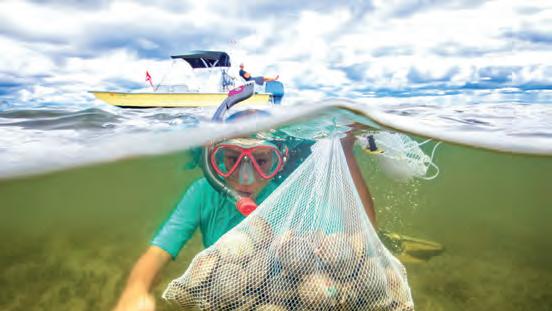

Summertime on the lagoons means one thing as a kayak angler, explosive topwater lure strikes in low light. The influx of bait we see to the shallows gets every predator fired up and looking for a substantial meal and a top water plug tends to get their attention. All four of our top lagoon species (redfish, seatrout, snook, and tarpon) will readily strike a well worked topwater and there is little doubt that the strike experienced with this tactic is addictive. Many anglers lean towards the walk-the-dog lures to get the hits we are after. The zig zag motion of these baits seems to illicit a better response than in-line lures like prop baits and chuggers. It does take a bit of time and practice to get the proper retrieve dialed in, but when you do it’s well worth the work. Just remember the lure is designed to do the right thing and you just let it work.
Short pulses of your rod tip and a slow reel is a good place to start. One of the best tips learned over the years of fishing and guiding when it comes to the topwater strikeonly set the hook when you feel the weight of a fish. Many times, folks will set the hook when they see the strike and pull the bait away from them. Always be sure to continue working that lure if you do miss a hit. Many caught fish have fallen victim to keeping that lure moving and getting a third, fourth, or more strikes. Even though topwater lures can produce hits throughout the day, without a doubt they are deadliest in low light conditions. The early morning until that sun gets up in the sky or the golden hour as the sun sets and settles on the west horizon are best. Colors don’t seem to make much of a difference. However, always have a bone/white, silver/black back, and red head white body in the tackle box. Is there a preference when it comes to size and rattle? Use larger plugs with louder rattles when the water has texture or is more than 2ft deep even if it’s slick. When the water is sub 2ft deep and especially if it’s slick glass calm, downsize the plugs and go with a less aggressive rattle or none at all. You can also slow the retrieve from a more erratic style to a subtle slower presentation. All throughout the heavier bait times and until the waters chill with winter cold this is one of the absolute favorite ways to get anglers hooked up.
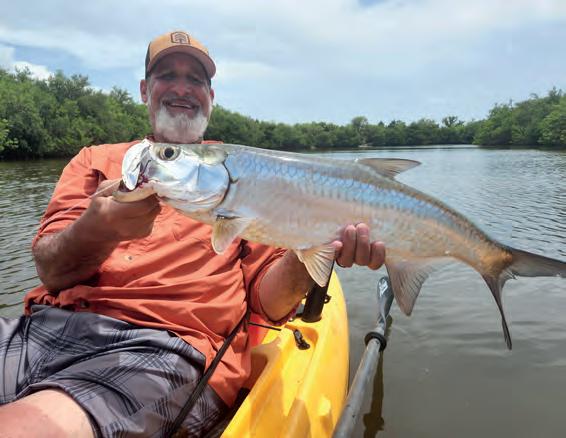

Supplying quality custom waterjet cutting, welding, and metal fabrication services. We pride ourselves in efficient, accurate & timely service. We work with a variety of clients, including Orlando-based theme parks, machine shops, ride manufacturers, vendors in tile, granite and glass, sign shops, a variety of small businesses, international businesses, and others, as requested.
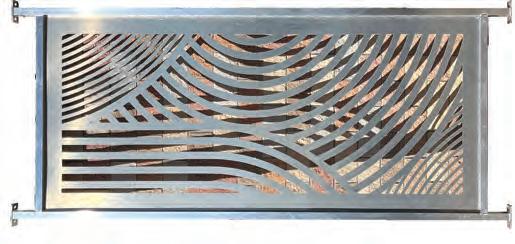







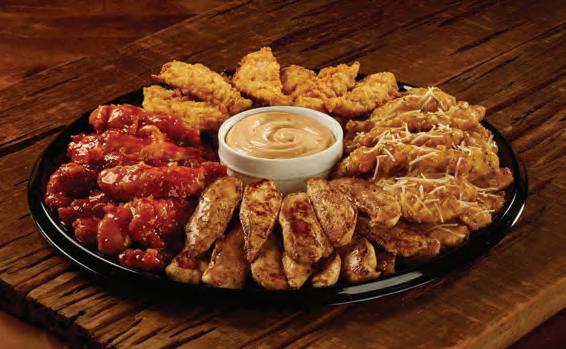


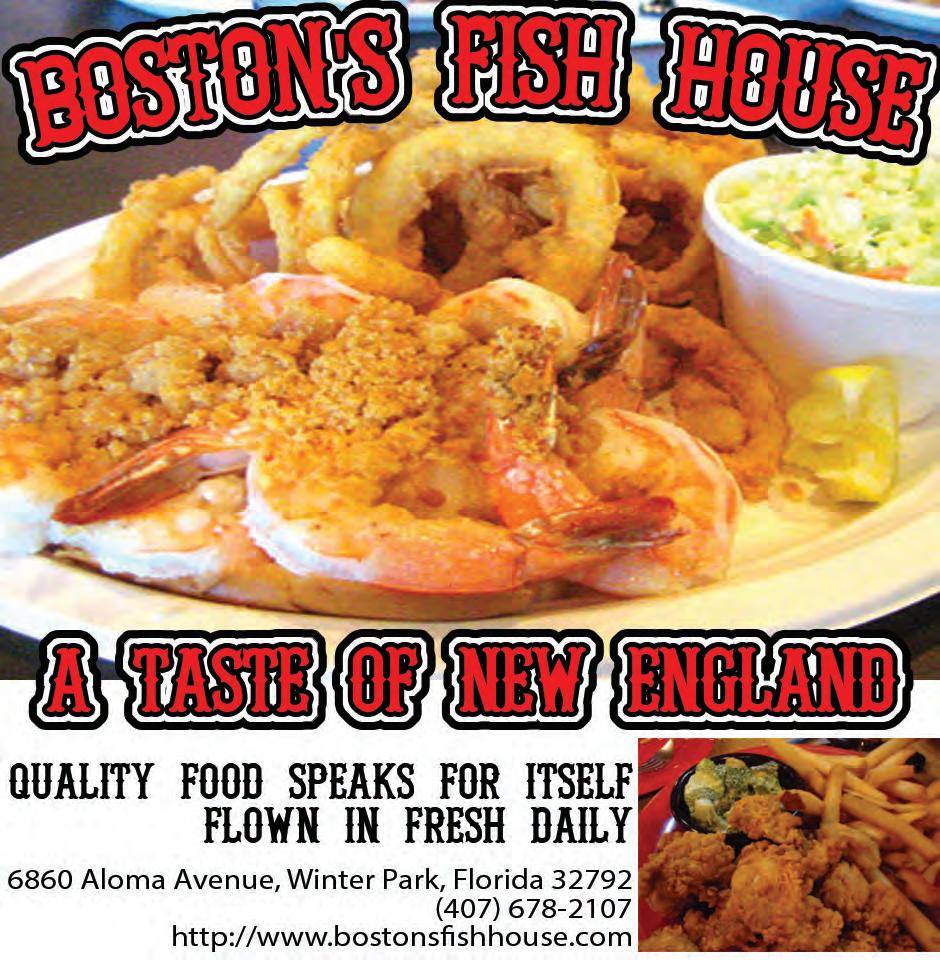

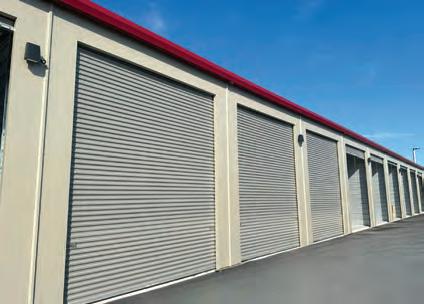









On Solid Ground RV and Boat Storage is proud to bring premium boat storage to the Space Coast!
We are conveniently located just minutes from the coast and Port Canaveral, perfect for storing your weekend water toys so when you’re ready, you’re right by the action.
Our state-of-the-art security system includes 24/7 surveillance cameras, electronic gated access, and on-site management to ensure your RV or boat is safe and secure at all times. Our top-tier amenities include on-site dump stations, water and electric hookups, and a wash bay for easy maintenance.
With over 270 spaces available, we have options to fit all sizes of RVs and boats. Whether you’re looking for a simple uncovered spot, a canopy covered space, or a fully enclosed unit, we have the perfect storage solution for you. Don’t wait, call us today to reserve your space and take the hassle out of storing your weekend water toys!





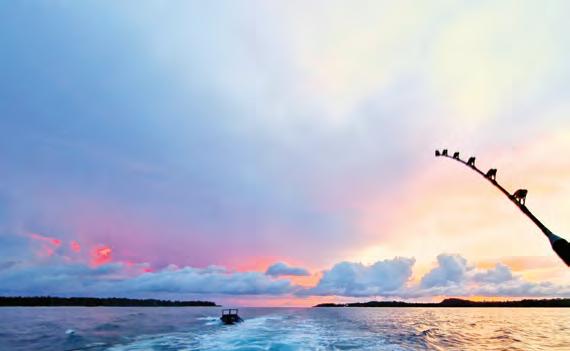
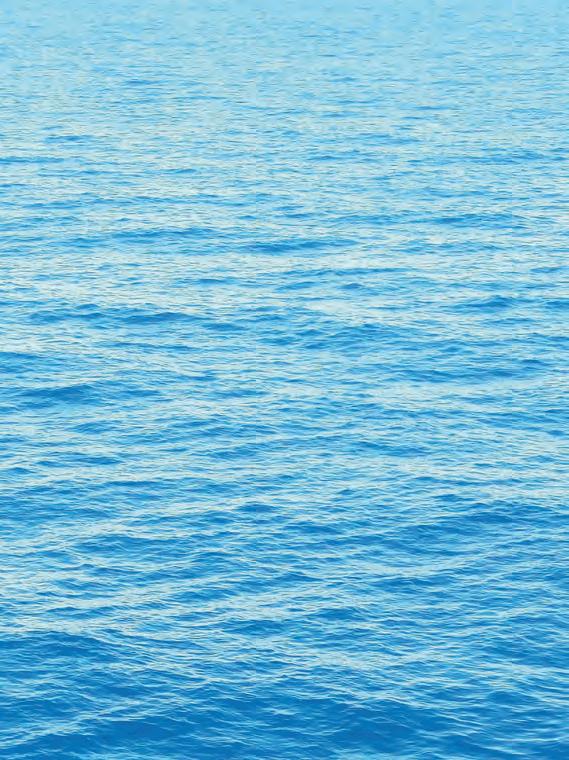



Happy 4th of July!
Fishing has been decent lately. A few mahi have been scattered around and a few cobia as well. Most of the mahi, kings and cobia have been on the reefs. Get your live bait and just go slow trolling. The bunker have been fairly easy to net lately. Watch your machines, look for the birds or, even easier, you can follow the fleet. They have been from the back basins to the pier.
This is usually the time of month that all the fish move in close to the beach. If you’re catching bait close just start fishing outside the pods. Worst case, you don’t catch anything and head offshore anyway. Don’t leave fish to find fish. Tarpon and crevalles have been around to have some fun with.
At some point later this month expect it to completely shut down and become a dump. Why, you ask? Every year we have the cold-water upwelling show up which chills the water drastically and usually shuts the bite down. This does a few things; it makes it harder to locate the bait and it pushes the fish out of the area till the warm water returns. It’s actually pretty cool. Check your bottom weights and I’m sure they will be nearly frozen. If that’s going on then be sure the bite is gone. The other thing this does is enables every person on a boat to become a professional cobia fisherman. (I personally feel the cobia should be off limits during this upwelling, but that’s for the rocket scientists to figure out because they clearly know what they’re doing.) Yes, the cobia will show up at some point on those shoals; this is by no means a secret. Let’s at least have just a little bit of etiquette. If a boat happens to spot a fish, let them fish. No need to rush up on them and start throwing your jig over their lines to attempt to catch the fish they spotted. Every year I see so much disrespect. And especially give the charter boats trying to make a living a little room. It’s already hard enough with a charter on board.

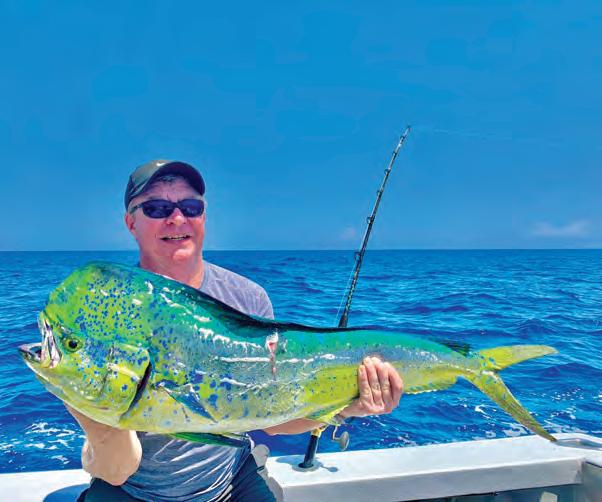







Anglers can expect fishing to be just about as hot as the weather this month. Capt. Justin and I will be taking our charter customers to the beaches outside of the Port which usually produce good numbers of tarpon, a variety of shark, cobia and king mackerel this month. The “bite” is determined by the availability of baitfish on most days. Anglers will be looking for pods of pogies, greenies, pilchards, and even glass minnows to fish around because these are the food sources for the predators we are seeking. Anglers can try jigging in and around these bait pods with a cobia jig or other large jig head tipped with a live baitfish. During morning and evening periods you can cast other types of lures like Storm swim baits, large spoons or Rapala lipped diving plugs. These various predator species will often hit an artificial lure when the light conditions or visibility isn’t all that good. Look for the pods of baitfish that are shifting or moving erratically in the water. This is an indication that the baitfish are being attacked from below by the previously mentioned predators.





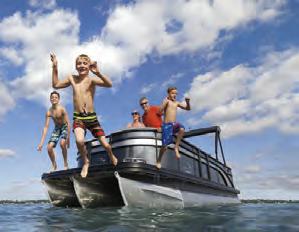
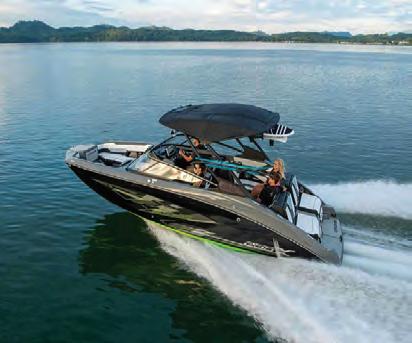


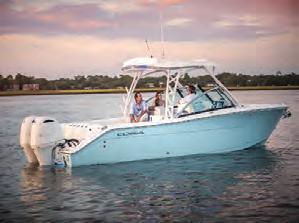

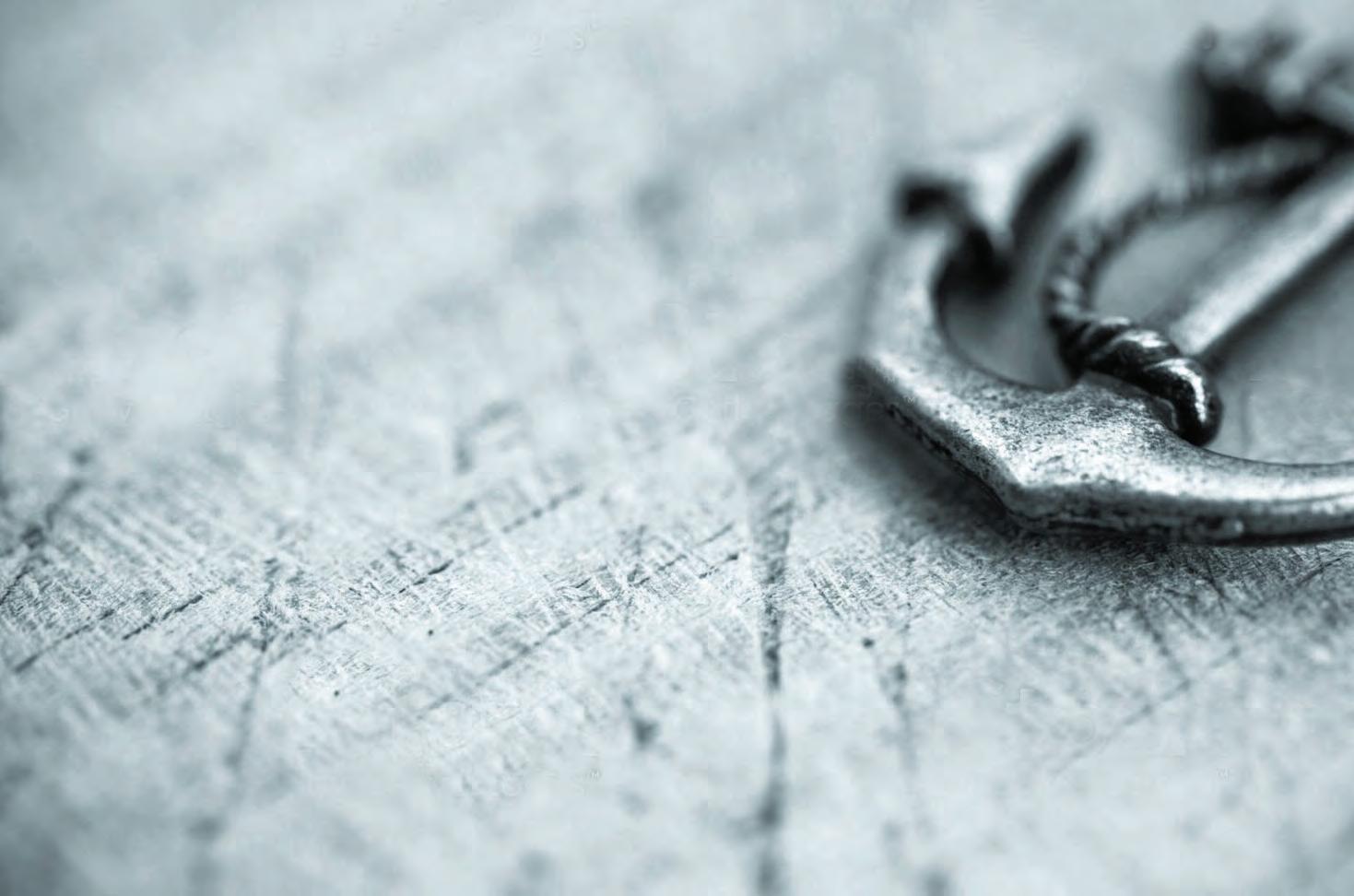


Saltwater fly fishing, in my opinion, is one of the most exciting experiences for an angler. Hello, and welcome to this month’s edition of Pro Tips. My name is Capt. Jonathan Moss of Go Castaway Fishing Charters and host of The Captain’s Log TV and I am thrilled to have you on board!
Presenting a fly made of feathers and fur to a fish and watching its natural instinct kick in as it eats is the pinnacle of fly fishing. That is the thrill, experience and adrenaline rush that all fly anglers seek. And what does it all have in common? Casting fly line.
Fly line can be frustrating. It seems to find any and everything to snag. Trolling motors, cleats, casting platform brackets, shoes; whatever it is, fly line will wrap itself around it. These are all things anglers can work on and pay attention to, but one easy and commonly overlooked aspect of fly line is its cleanliness. Clean fly line will always cast smoother and farther as there is less dirt and grime attached which causes friction while casting. Cleaning fly line is very simple and in this article I want to offer a very easy and cheap solution to cleaning fly line.
To get the started you will need the following:
1. Bucket/container with warm water.
2. Mild dish soap.
3. Paper towels or a clean microfiber rag.
4. Fly line dressing and cleaning pad (E xtra step that is worth the expense)
Step 1: Strip the fly line from the reel and soak for 15 minutes in a bucket with warm water and dish soap.
Step 2: Rinse the line in the sink and let soak for 15 minutes in a bucket with just warm water. You can reuse the first bucket, just be sure to rinse the soap out well.
Step 3: Dry and wipe the line by pulling the line through a paper towel
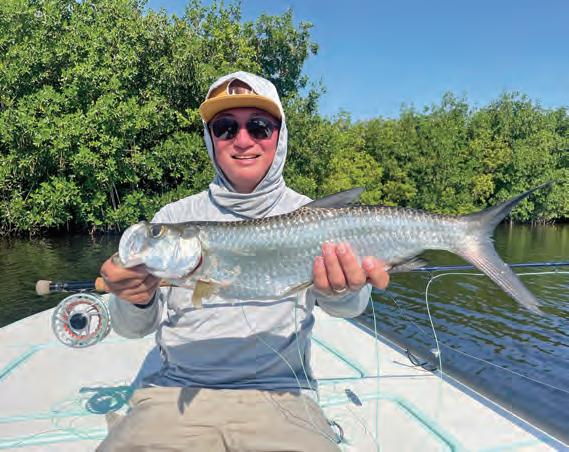
or microfiber towel. Be sure to apply tension while pulling the line to dry and wipe as much extra grime residue off the line.
Step 4: Reel the now clean line back onto the spool. It is during this step that, if desired, a fly line dressing and cleaning pad may be used. Dressing and cleaning pads do make a difference but are not required.
Tight lines! CAPT.
JONATHAN MOSSGo Castaway Fishing Charters www.gocastaway.com
www.thecaptainslogtv.com (407) 760-8593


une started out with heavy winds out of the northeast and rough seas making beach fishing tough. July should bring west winds and a lot of heat, and possibly some upwellings and cold water which shuts down the inlet bite. July is one of my favorite months of the year to fish the beaches from Melbourne down to Sebastian Inlet for snook, snapper, kingfish, jacks and tarpon from the beaches with live bait, artificial and on fly. Anglers can fish from the beach with live baits as well as their favorite hard and soft baits; good action should be had on all types. Look for schools of baits such as glass minnows, greenies or menhaden and fish bait pods close to the beach for consistent action.
The islands or mangrove shorelines in the Indian River Lagoon from Palm Bay to Sebastian should be good at early morning as long as there is bait in the lagoon. We could use some more rain to help push some of the bait out of the creeks and into the lagoon around the spoil islands and mangrove shorelines to keep the predators happy. Topwater baits such as Rapala’s Skitter Walk as the sun comes up and as it sets should be a sure bet for trout, snook or redfish. If the fish won’t hit topwater, go subsurface with the Rapala’s Twitchin’ Mullet or D.O.A. 4” jerk baits and 3” paddle tail baits. Look for bait pods in the areas you are fishing and work the bait pods, cast under the mangroves and along the deeper parts of the spoil islands. The bite will be
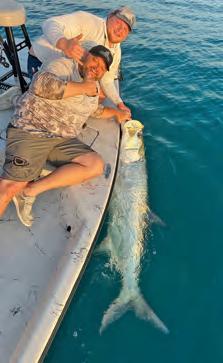

early and shut down once the sun comes up and temperatures increase.
The creeks from Sebastian to Melbourne will hold snook and tarpon this month and hopefully we can get some rain to push water out. Fish the mouths of the creeks or way back in the creeks for big tarpon on live mullet, greenies or pilchards or go with topwaters early and late in the day. Fish the docks back in the creeks for snook as well as big trout, redfish and some jack crevalle.

Whether fishing the beaches or the lagoon, be aware of the clouds forming and make sure to get off the water before you get caught in a lightning or hail storm as they come up quick and can be very dangerous.
CAPT. GLYN AUSTIN
Going Coastal Charters www.goingcoastalcharters.com (321) 863-8085












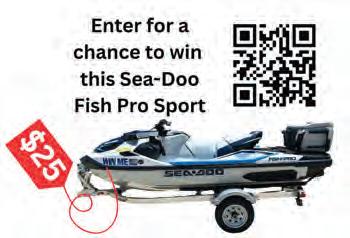
Thursday August 8th
Captain’s Party at 6pm at Sebastian Saltwater Marina
Friday August 9th
Lines in at 9pm
Saturday August 10th
Lines out at 9pm
Sunday August 11th
Weigh-in: Sebastian Saltwater Marina from 11AM-2PM
Awards: Following Weigh-in
The heat of the summer is on, marking July as a complete shift from spring fishing tactics. While similar surf fishing techniques will hold true, there’s different species available in the summer months. Below we’ll discuss our game plan for Space Coast surf fishing techniques during the summer months.
Old habits die hard as they say. Meaning, look to change up your traditional pompano rigs and rod holders for spinning gear—rods and reels with the capability of casting live baits and lures. This is due to the fact that species including snook, tarpon and flounder are present in the summertime surf. To effectively target these species requires a different approach than fall through spring seasons.
Firstly, one of my favorite styles of fishing in the summer is the “light pack on the move” approach. For example, walking the beach with one rod and a light pack with various lures. These lures should include bucktails, swimbaits, diving plugs and jigs. Use the mobile approach by walking the shorelines and casting said lures in the nearshore troughs. Ambush predators such as snook and tarpon will be feeding in these zones during dawn and dusk. Due to the heat factor in the middle of the day, it’s best to avoid those times.
Secondly, if you don’t feel like casting repeatedly as you walk the shore then feel free to set up in a productive area. This requires using a series of rods with live bait. The live bait can be anything from finger mullet to croakers or even

live shrimp. Use a fish finder rig with one to three ounces of weight and a 4/0-6/0 circle hook. Cast the live baits at various distances from the shore to present them in traditional feeding zones. The circle hooks will do the majority of the work, i.e., when you get a fish on just apply steady pressure to engage the circle hook.
Lastly, the pompano fishing in the summer may surprise the majority of surf fishermen. Due to the fact that the traditional pompano run takes place in winter and spring months, summertime is often forgotten about. But, I’m here to tell you, there are resident pompano available all
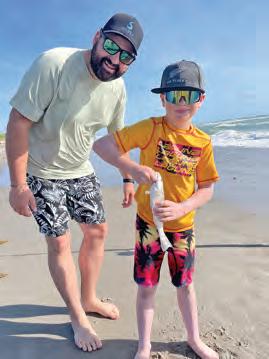
year in the surf. Some of my best pompano fishing has taken place when there wasn’t supposed to be any pompano around. For these reasons it makes for wise decisions to set up your pompano gear, coinciding with the above mentioned tactics. This gives surf fishing anglers a broad approach to capitalize on all the seasonal opportunities.
Cocoa Beach Surf Fishing Charters cocoabeachsurffishingcharters.com (321) 205-4672





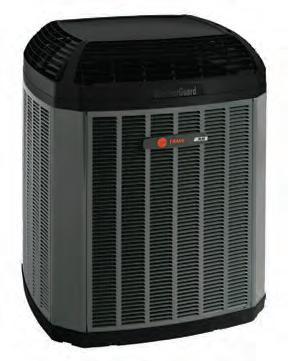






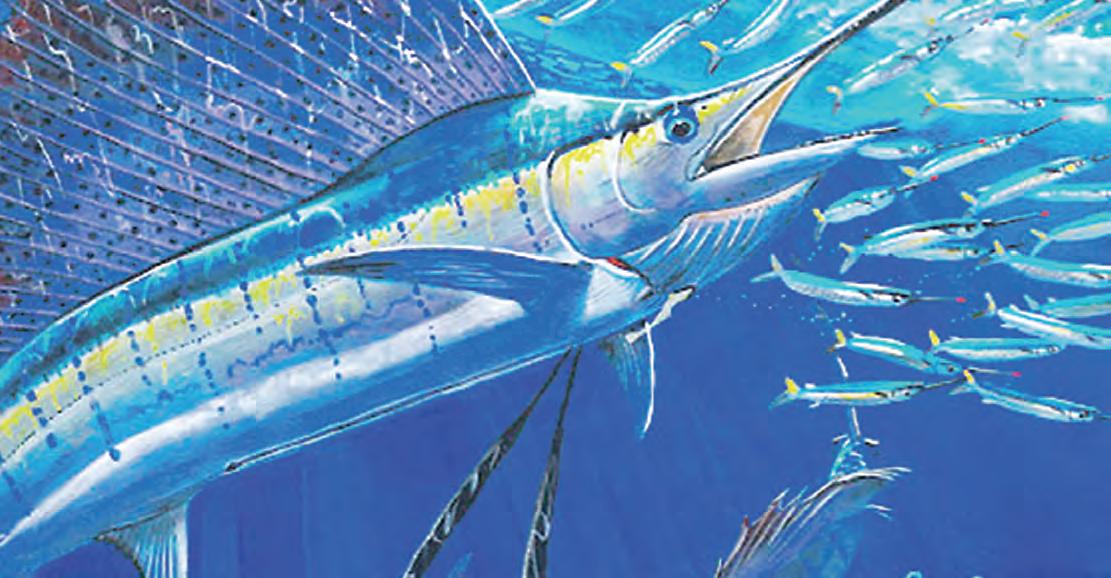
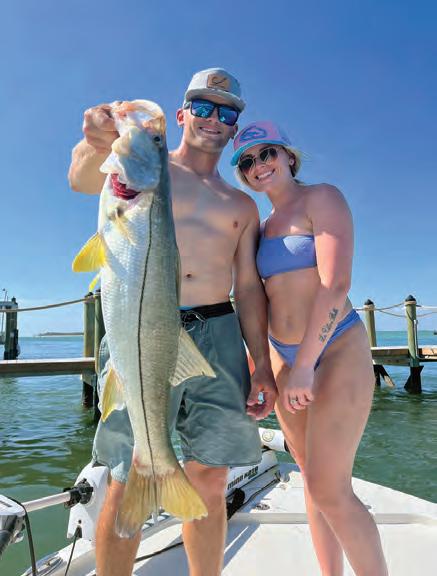
Shannon & Shane with a nice slot snook caught at Captiva Pass.

Nice spotted sea trout for Daniel Krieger.

The Matthews men with a beautiful snook they caught on a spring charter with Capt. Jonathan Moss on the Indian River.
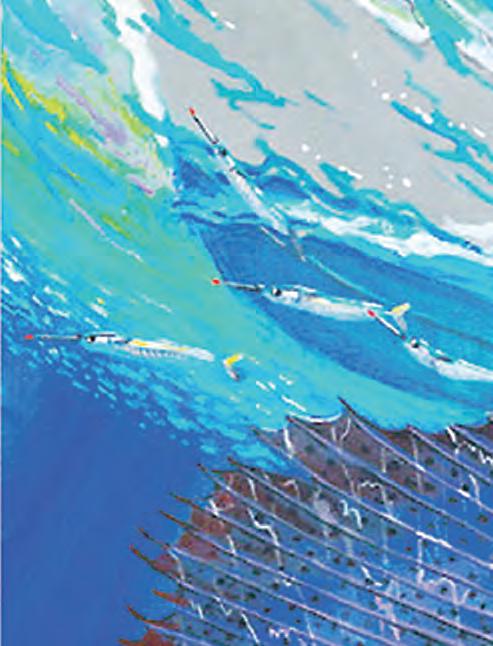

Angela Winters with a nice redfish she caught fishing the docks near Gasparilla Pass.
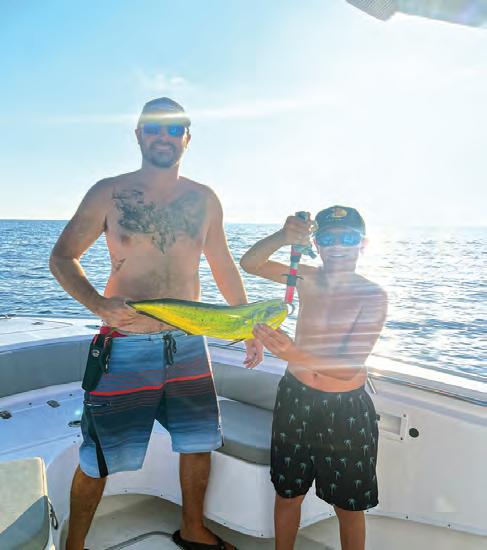
Junior anglers Leo (left) and Corey (right)
BOTH hooked their first mahi-mahis on a recent offshore fishing trip! Helping to show them off are proud dads Ross Smith and Sean Houle, respectively.
For your chance to get featured on the Brag Board, upload your high-quality photos (at least 1MB) along with all of the catch details at: coastalanglermag.com






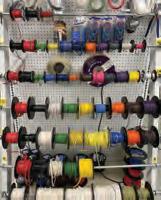








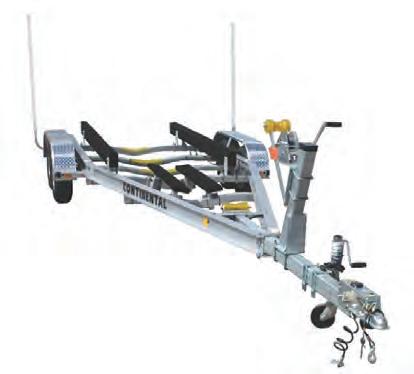






Fishing in the Everglades is always a blast, and sight-casting tripletails is one of the coolest challenges out there.
Tese fsh are unique with their three-tail look and tendency to hang out near foating debris. If you want to catch them, using live shrimp and spotting them is a great way to do it. Idle around and look for foating seaweed, as tripletails like to hang around that to camoufage.
Use polarized sunglasses to cut the glare and make it easier to spot them. Move slowly through these areas, keeping your eyes peeled, but fair warning— it’s not as easy as it sounds.
Once you see a tripletail, don’t rush in. Tey can be skittish, and sudden




moves or loud noises can scare them of. Drif toward them with the wind or current to avoid using your engine.
Tripletails love live shrimp, so get the liveliest, healthiest shrimp you can fnd. Hook them through the tail or behind the horn on their head so they stay active and attractive. Cast your shrimp past the tripletail and slowly bring it back toward them. Let the current make it look natural.
If the fsh is near the surface, just freeline it. If they’re deeper or the current is strong, add a little weight to keep the shrimp down. Sometimes it takes a while to fnd and approach tripletails, so don’t rush it.
Use light to medium tackle, 15- to 20-pound good since tripletails have sharp gill plates. Early morning or late a is usually best, since tripletails are more active and easier to spot then. should be around for the next couple of months of the summer.
Catching tripletail is truly a fun challenge that mixes the thrill of the hunt with the excitement of the catch. Whether you’re a fshing pro or just starting, targeting tripletails in the Everglades is an adventure you won’t forget.
If you are interested on getting on some Tripletail, book a charter with Bean Sportfshing, www.beansport
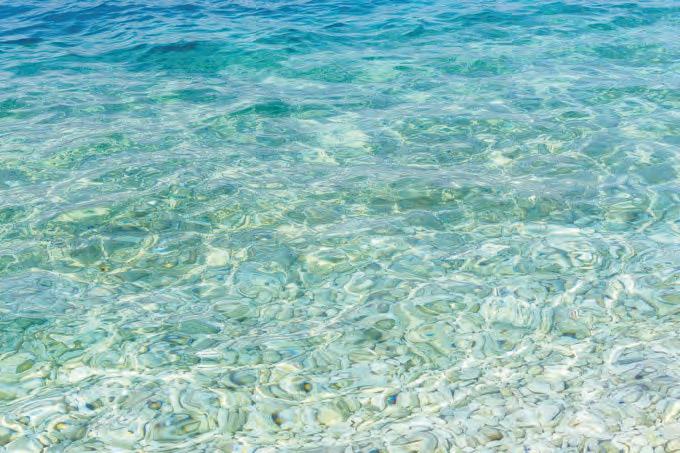




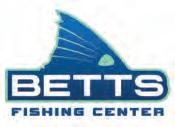


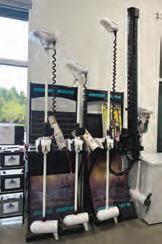











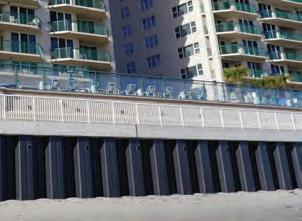
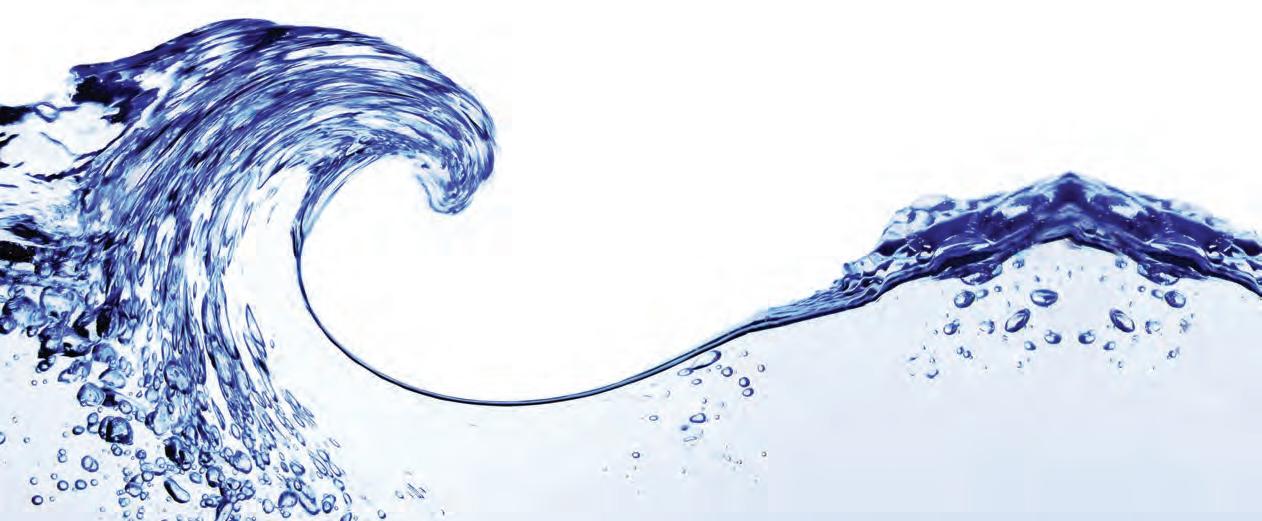

During the 2023-2024 bonefsh spawning season, researchers with the Bonefsh & Tarpon Trust documented, for the frst time, bonefsh prespawning aggregation sites in Florida. Te frst was discovered in the Upper Florida Keys and the second is a suspected site found near Key West. Tese discoveries are a hopeful sign of continued recovery for the species afer a decades-long decline.
“Finding these nearshore areas where bonefsh school by the thousands before migrating ofshore to spawn in deep water is essential for their conservation,” said Jim McDufe, BTT President and CE0. “As our science team continues to identify these sites, we will work with our state and federal partners to ensure that they are protected, ensuring a healthy future for one of Florida’s most iconic fsh species.”
Over the course of the 2023-2024 bonefsh spawning season, which spans from October to April, BTT Florida Keys Initiative Director Dr. Ross Boucek and his team tagged 44 bonefsh with acoustic transmitters with the help of Florida Keys fshing guides. BTT scientists also deployed 37 acoustic receivers on the reef tract, which allow them to monitor bonefsh spawning movements.
“We documented seven spawning events during the 2023-2024 spawning season,” said Dr. Boucek. “Four bonefsh tagged with archival depth measuring tags spawned during these events; three of the four fsh recorded maximum depths of 332 feet, 310 feet, 302 feet. Te fourth fsh recorded a maximum depth of 180 feet on its frst possible spawning or false spawning attempt. Te recorded spawning depth of approximately 300 feet is consistent between the Upper Key spawning site and the suspected spawning site near Key West, and with recorded spawning events in Te Bahamas.”
During full and new moon cycles from fall through early spring, bonefsh


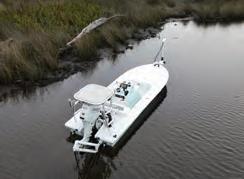





migrate 70 miles or more from their home ranges to nearshore pre-spawning aggregation sites, where they prepare to spawn by gulping air to fll their swim bladders. At night, they swim ofshore and dive hundreds of feet before surging back up to the surface. It is believed the sudden change in pressure as they ascend makes their swim bladders expand, causing them to release their eggs and sperm. Afer fertilization takes place, the eggs hatch in about 24 hours, and the larvae drif in ocean currents for between 41 and 71 days before settling in shallow sand- or mud-bottom bays, where they develop into juvenile bonefsh.
“Our long-term goals are to conserve the reproductive cycle of our growing bonefsh in the Florida Keys,” said Dr. Boucek. “We still need to know where spawning occurs across the Keys, what threats like habitat loss those spawning fsh might face, where their larvae go, and the habitats the juveniles need to ensure that our new population of bonefsh can reach their full potential.”
For more information, go to bonefshtarpontrust.org.

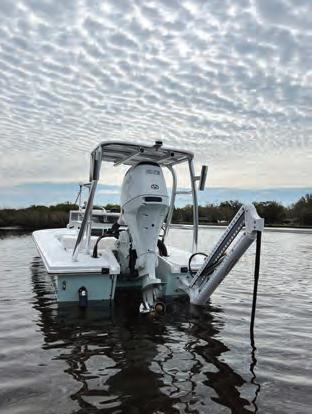

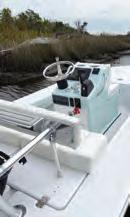
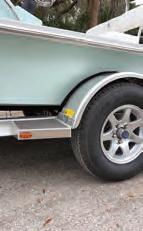

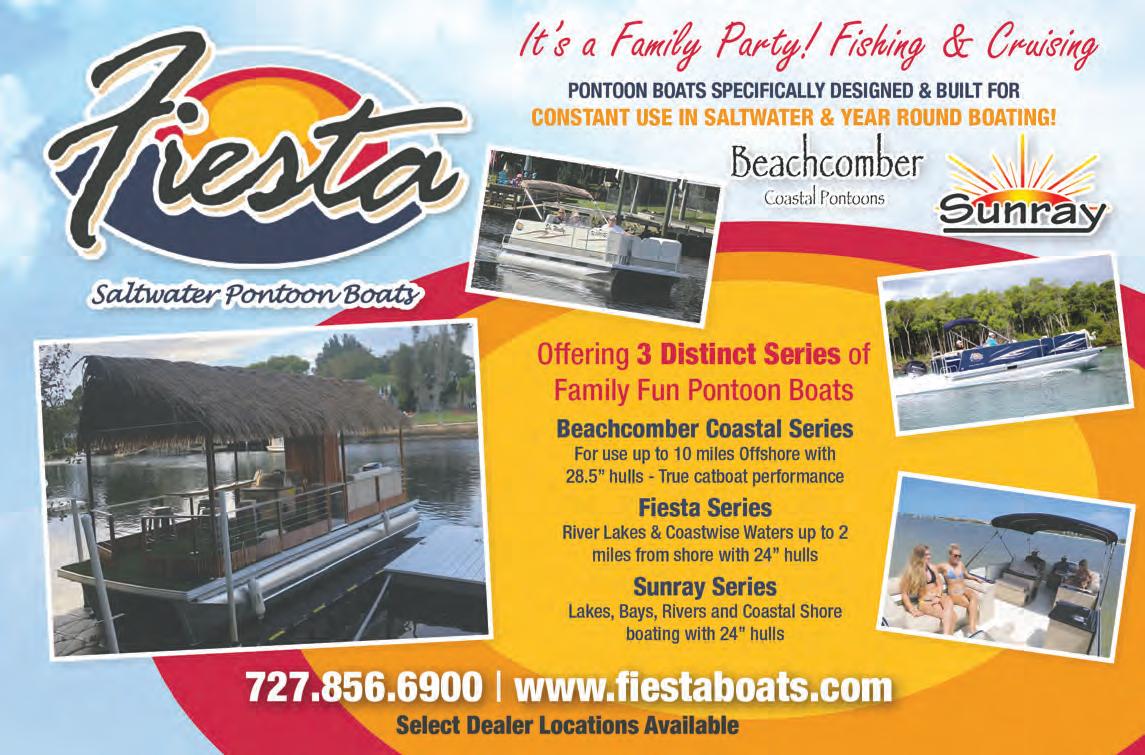










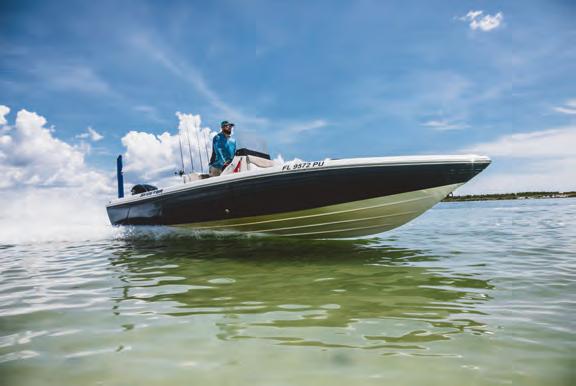






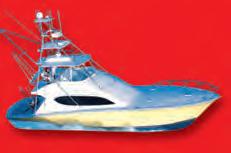









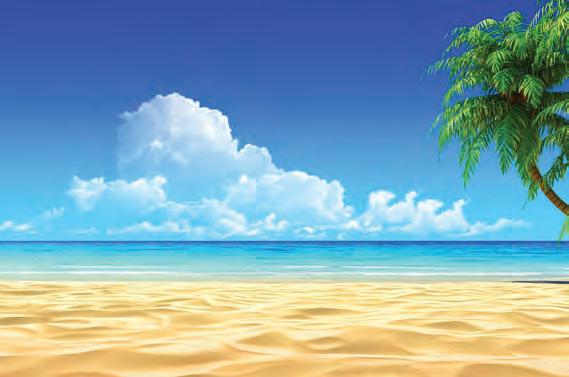

Regulations change and so do reporting and license requirements. Here are some things FWC wants you to remember before you head out on the water.
1. Get a License and Reef Fish Angler Designation
In addition to a fshing license, you’ll need a State Reef Fish Angler designation if you plan to target any of the following reef species: mutton snapper, yellowtail snapper, hogfsh, red snapper, vermillion snapper, gag grouper, red grouper, black grouper, greater amberjack, lesser amberjack, banded rudderfsh, almaco jack and gray triggerfsh.
Te State Reef Fish Angler designation is free and required for all anglers fshing from private recreational vessels for reef fsh. Tis includes anglers who are exempt from a regular fshing license. Tis free-of-charge designation is used to help fsheries managers improve recreational data of reef fsh, which helps improve the management of our fsheries.
Get your license and State Reef Fish Angler designation online at GoOutdoorsFlorida.com, in person at a license agent or tax collector’s ofce or by calling toll-free 888-FISH-FLORIDA (888-347-4356).
2. Know the Regulations
Know the regulations for the species you are targeting, as well as those you might catch incidentally, before you drop a line. When you reel in a fsh, you will know whether or not you can throw it in the fsh box.
Tere are also specifc reef fsh gear rules, such as using non-stainless steel circle hooks, a dehooking device and a descending device or venting tool. Check regulations in the area you plan to fshing by visiting MyFWC. com/ReefFishGear.
3. Have the Correct Release Gear
Quick and proper use of a descending device or venting tool can help fsh get back down to depth and improve their chance of survival. Such a tool must be onboard when you are targeting reef fsh, and you should know how to properly use it to alleviate barotrauma in fsh hauled from the depths.
Venting tools are sharpened, hollow instruments designed to release expanded gases in the swim bladder of fsh experiencing barotrauma. Knives, ice picks and hooks are not legal venting tools and ofen cause more harm to the fsh than good.
To learn more about barotrauma and how to use descending devices or venting tools, visit MyFWC.com/Barotrauma or check out ReturnEmRight.org/ BestPractices, where you could be eligible to receive free descending device gear.

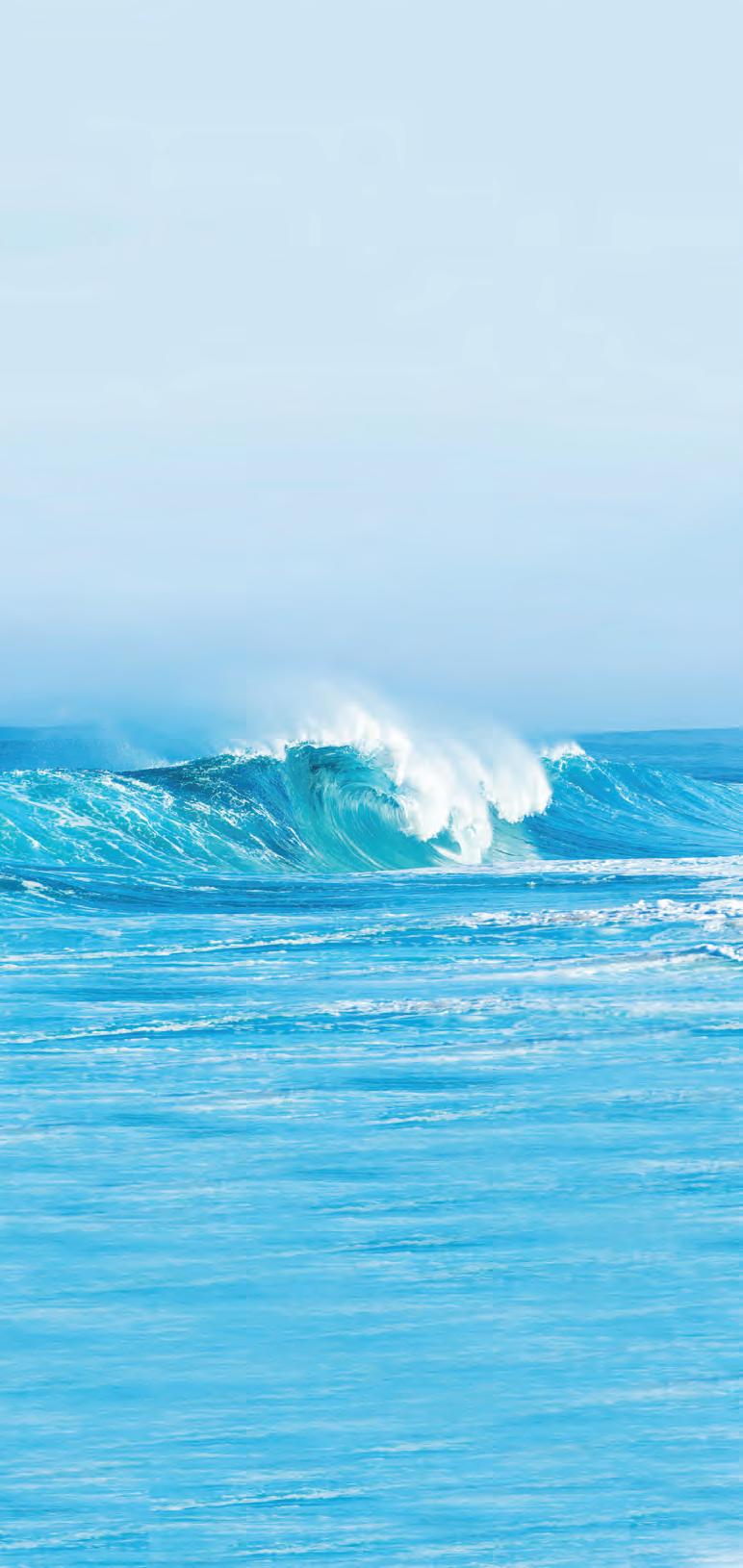



For the past two years, I’ve had the pleasure of taking Coastal Conservation Association’s Leiza Fitzgerald out on the water to assist in tagging dolphinfsh for the CCA STAR competition. As if going fshing wasn’t enough of a prize, recreational anglers can sign up for this competition, with a donation to a good cause, and participate in this fshing side quest for all sorts of epic prizes.
Tagging trips with Leiza are some of my favorite mahi trips. She is more excited about catching throw-backs than anything we put in the box. Each undersized mahi, and most of the keepers, are handled with care and released with some fancy new jewelry.
With her tagging gun locked and loaded and a towel to lay over the fsh’s eyes to calm them, Leiza carefully and quickly turns peanuts into prizes, and sends them on their way.
CCA Florida STAR presented by Yamaha is a summer-long event that invites anglers and non-anglers to participate and win prizes valued at almost $500,000, including boats, motors, scholarships and more. Te competition is currently live, and registration is open until Sept. 2.
“In the past nine years, it’s been amazing to see STAR participants support conservation and embrace the catch-photo format,” Fitzgerald
said. “Awarding nearly $4 million in prizes, with $900,000 specifcally awarded in youth scholarships to the thousands of statewide STAR registrants is exciting, but even more exciting is the awareness STAR has created for the conservation of our marine fsheries.”
Te 2024 STAR competition is comprised of eight divisions targeting inshore and ofshore species along with trash cleanup. Wherever your home waters are, there is a way to get involved.
Te most notable of the STAR competitions is for tagged redfsh. Te best opportunity to catch this year’s tagged redfsh will be in Citrus and Charlotte counties, STAR’s 2024 Destination Counties, which each have eight tagged redfsh in their coastal waters.

Six years ago, STAR initiated a tagged fsh division for ofshore anglers, the Tigress Outriggers and Gear Tagged Dolphin Division. Tis division ofers one winner a $10,000 cash prize or scholarship. Te frst STAR registrant who catches a STAR tagged dolphin wins.

Te tagged dolphinfsh were caught and released of the Florida Keys. Tese fsh will migrate up the east and west coasts, providing anglers a shot at recapturing one. Tere have only been two tagged dolphin recaptured in six years, and neither angler was registered in the competition. You have to be in it to win it!
Make sure to report any tagged fsh you catch, whether you are registered or not. Take photos, measurements, tag numbers and information, and note the location of recapture. You do not need to remove the tag if you are releasing the fsh.
Fish are very mysterious, and there is so much we don’t know about them. Te more data we collect, the better conservation we can provide.
Capt. Quinlyn Haddon; Sweet E’nuf Charters, Marathon, Florida Keys; @captainquinlyn; captainquinlyn.com; (504) 920-6342.
- $80 Entry (includes one year CCA membership)
- $40 Entry for current CCA members
- FREE for Youth
- Over 100 Days of Fishing
- $500,000 in Prizes & Scholarships
- Memorial Day Weekend to Labor Day









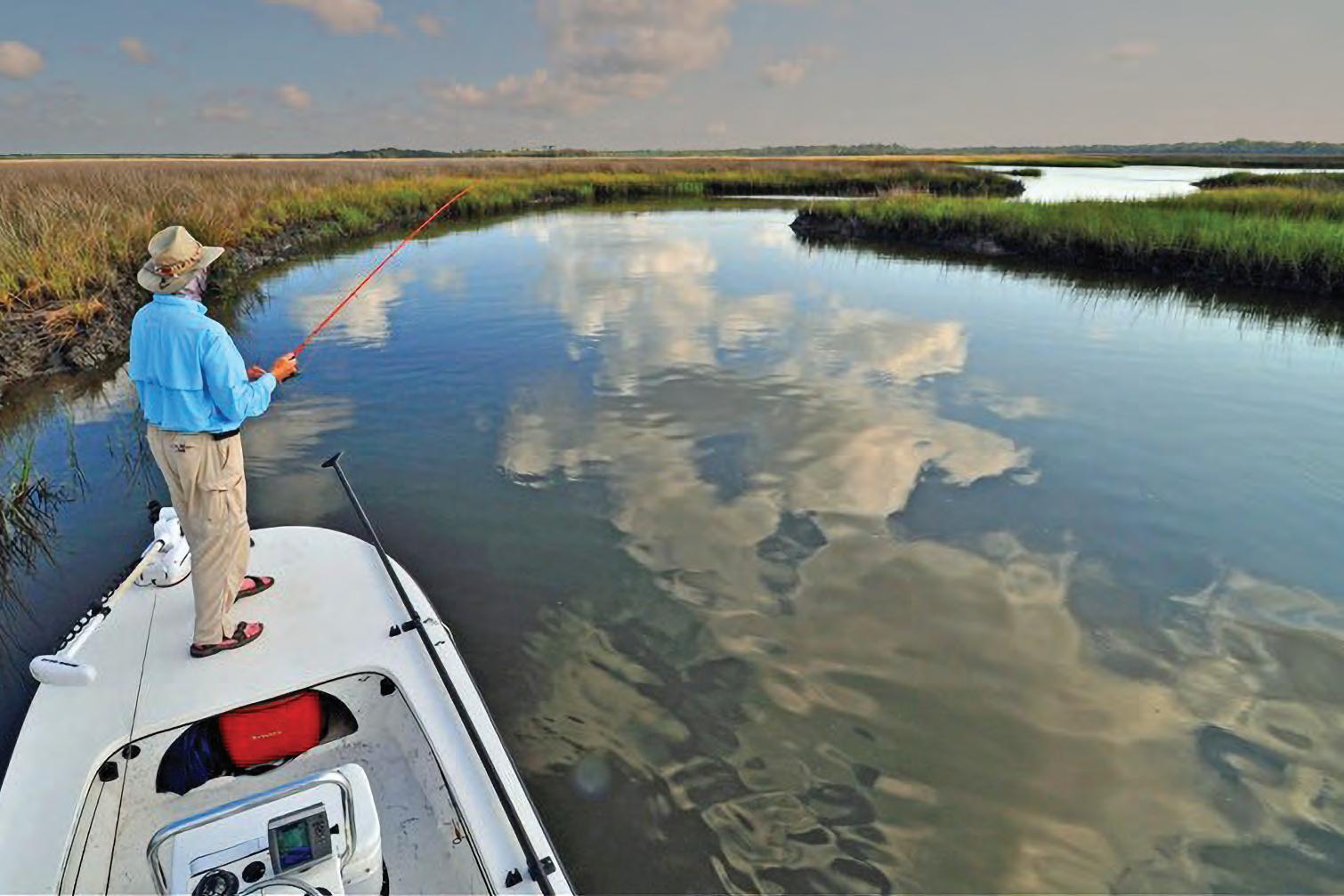
Fishing during the hot stale days of summer is ofen thought to be the toughest and slowest fshing there is. I am here to help with that.
Not only are the next few months an amazing time to catch fsh, they can also be the easiest time to pin-point patterns for big bass. Spawning bluegills are the key. Bass will set up around bluegill beds and feed heavily on an easy meal of bluegills that congregate in the shallows to spawn.
Whether you are an experienced tournament fsherman or someone who just gets out every once in a while to stretch a line, this pattern is easily found if you know what to look and listen for.
You heard me right, listen! Tere are many ways to locate bluegill beds, and my favorite way is to use my ears. When you get around bluegills feeding in grass or lily pads, you will hear distinct little popping sounds of small fsh sucking prey from the surface. When you hear this, you know you are in a productive area, and the big bass should be close by.
Another way to locate these areas is to use your eyes in shallow water. Bluegill fan

out an area on the bottom just like a bass when they spawn, but they do it in big groups and create a pattern on sand and hard bottom that looks like the surface of the moon.
If the water is even a little clear, you should be able to spot a bunch of odd craters and divots on the bottom even from a distance. Tis is typically in very shallow water, and bass use this shallow water to their advantage. Spawning bream make easy pickings.
If all else fails, or in murky water, I fnd these beds with my electronics. I idle around with side scan in 2 to 5 feet of water to locate crater patterns on my units and mark them with waypoints to come back and fsh later. Tis is a good way to locate beds that are less pressured, because they are harder for other anglers to fnd.
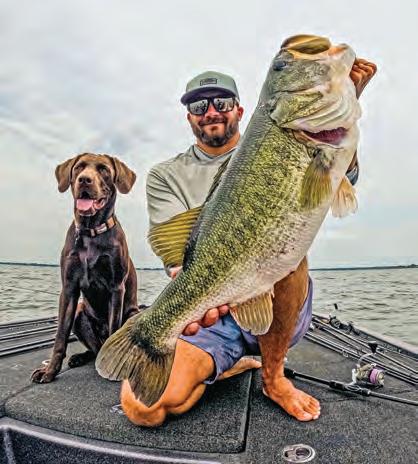
Tere are a few diferent baits I use to catch bass around these beds. Te most important thing is to stay as far away from these areas as you can, while still being able to get a cast into them. Be stealthy because shallow-water bass are skittish.
I like a bluegill-colored popping frog and also a bluegill-colored swim jig with a trailer to match. I’ll also throw a weightless wacky-rigged Senko and will put a little nail weight in the Senko when fshing deeper beds. A lightweight Carolina-rigged Trick Worm or a shallow-diving squarebill crankbait are two other good options. Hopefully this summertime bass tip helps you have a fun and productive day on your waters!
Tyler Woolcott is a professional tournament angler and guide. Check out his website at www.tylerwoolcottfshing.com.
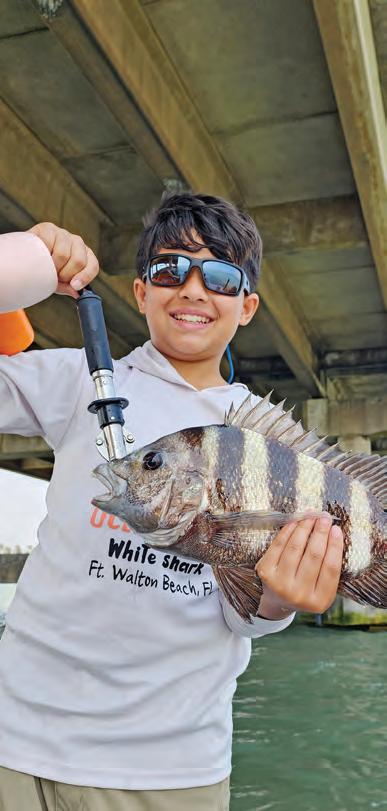
When we inshore anglers gather around the dock, you can count on one or more of these being the topic of conversation: trout, redfsh, founder or snook. Seldom is it the sheepshead. Although they are not a species frequently targeted with lures, they can provide an aggressive bite and a worthy fght. Keeping them out of the structure they love is the real challenge.
 By Capt. Michael Okruhlik
By Capt. Michael Okruhlik
depending on the current, were all it took to place his shrimp in the strike zone. Te strike zone is typically as close to the structure as possible. If you notice the sheepshead swimming around, they always have their noses to the structure.
Te sheepshead is a fsh that my son had never caught until a few weeks ago. We took a trip to South Texas to view our second of four Starship launches at the SpaceX facility. Afer the excitement and rumble of the launch, we picked up some live shrimp, and he was soon rumbling with many sheepshead.
We set our sights on the Queen Isabella Memorial Causeway, as it has a nearly unlimited amount of structure ideal for attracting sheepshead. Using the anchor mode on our trolling motor made it easy to stay close to the bridge pilings where the sheepshead were congregated. My son especially liked targeting them because we were under the causeway and in the shade, as opposed to being out on the open fats where we typically fsh.
A small sharp hook and a split-shot or two,
I fnd that keeping your bait small helps attract the bite. It is benefcial to keep a tight line, as the bites can be very light. One tactic that served my son well was to walk toward the back of the boat and away from the structure once a fsh was hooked. Tis assisted in pulling it away from the structure. Trying to manhandle the fsh out on light tackle would certainly have led to some break-ofs.
Stay vigilant in checking your line for frays afer several casts and defnitely afer each fsh. Keeping a sharp hook will also help in landing more fsh because of their boney, teeth-flled mouths. Tis turned out to be an extra memorable fshing trip. We witnessed another historic space launch, and his catch landed him in second place for the Texas CCA Star Tournament with his sheepshead.
Tis is why I always say, take a kid fshing! Tey might win a college scholarship.
Capt. Michael Okruhlik is the inventor of Knockin Tail Lures®, and the owner of www.MyCoastOutdoors.com.





Amonster blackfn tuna caught during Te Miami Dolphins Fins Weekend tournament is an unofcial world record. Te 50.1-pound blackfn was certifed by an IGFA biologist, and it outweighs the existing IGFA all-tackle world record by a little less than three-quarters of a pound.
Angler Robert (Bob) Kowalski landed the huge blackfn aboard the 34’ Express Sportfsher Miss Britt, which was captained by Gareth Haddam and chartered by Pete Sinnick and his family. In addition to being a potential new world record, the fsh won the largest tuna division at the tournament and earned the team a $30,000 payout.

Te existing IGFA all-tackle world record blackfn tuna weighed 49 pounds, 6 ounces. It was caught in 2006 of Marathon, Florida Keys by Capt. Mathew Pullen. Fins Weekend is an annual fundraiser hosted by the Miami Dolphins. It is a two-day tournament with proceeds going to support the Baptist Health Orthopedic Institute Youth Athletic Outreach Program. For more information, go to bluewatermovements.com.


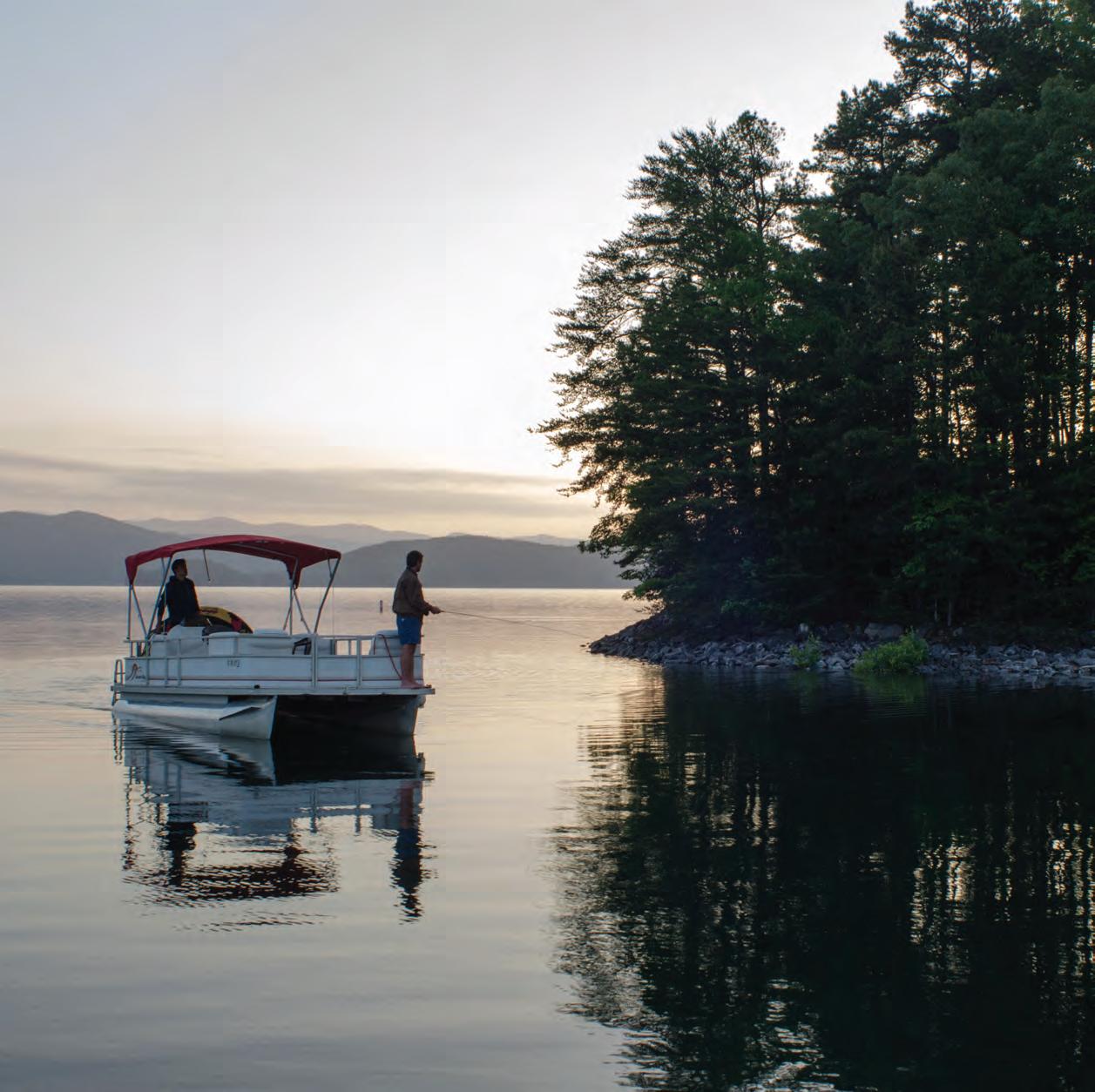







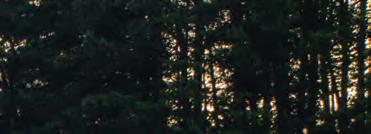



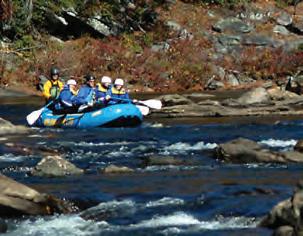
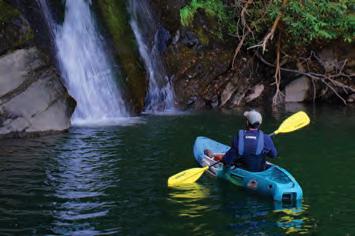

When it comes to growing giant largemouth bass, Texas has fgured some things out. Since 1986, the state’s Toyota ShareLunker program has conducted a breeding program using huge largemouths caught and donated alive by anglers. Tese donated bass, called Legacy Class, must be heavier than 13 pounds. Tey spawn in a facility before being released, along
with their ofspring, to spread big-fsh genetics across the state.
Te results of the program are apparent in the giant Texas bass caught each year. Many of them go right back into the breeding program, and the spring of 2024 was the fourth ShareLunker season in a row that the program has deemed exceptional.
Tis spring, anglers contributed 19 Legacy Class, 13-plus-pound bass from seven diferent Texas lakes. O.H. Ivie in west Texas is the best big-bass fshery in the country right now. It produced 12 bass heavier than 13 pounds this season, continuing a hot streak that goes back to the 2021.
Highlights from the 2024 Toyota ShareLunker collection season:
• Angler Kyle Hall’s 15.82-pounder was the 37th heaviest all-time Texas largemouth bass.
• Angler Kyle Hall has recorded a Legacy Lunker in three consecutive seasons.
• Six out-of-state anglers etched their name into the program’s record book. Te anglers hailed from Kansas, New York, Ohio, Oklahoma and Washington.
• Angler Larry R. Walker reeled in two Legacy Class Lunkers in 2024. State biologists did genetic analysis of this year’s Legacy Lunkers and made some incredible discoveries:
• ShareLunker 666, reeled in by Larry R. Walker from O.H. Ivie, was a recapture of ShareLunker 646 originally caught by Mechelda Criswell in 2023.
• A 13.2-pound fsh from Lake Athens was the ofspring of ShareLunker 552, which was caught by Randall E. Claybourne in 2014 at Lake Fork. Tis is the frst time a Legacy Class descendant from this family tree was discovered in the program.
• Of the 19 Legacy Class ShareLunkers, 13 had secondary relationships to either previous Legacy Class fsh or other ShareLunkers from which anglers submitted scale samples for genetic analyses.
• In the last fve years, the program has achieved an excellent overall fsh survival success rate of 94 percent.
Tat’s a lot of big-fsh genetics going back into Texas fsheries.
For more information, go to TexasSharelunker.com.



















What Stauer Clients Are Saying About Our Knives

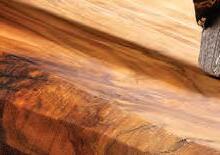
“Outstanding knife of high quality and a great price. I now have a number of your great cutlery in my growing collection!”
— Robert F., Richardson, TX






We know you. You’re not interested in everyday, run-ofthe-mill, common cutlery. You want something with a story, a unique feature that you can brag about. We’ve got just the thing for you. Our Mighty Conifer Knife is a unique tool with a Damascus steel blade and a handle crafted from an enhanced and stabilized natural pinecone. While our competitors are charging hundreds for similar knives, we’re offering the Mighty Conifer for JUST $99! Tat’s what we call our Stauer Impossible Price.
JOIN MORE THAN
PEOPLE WHO COLLECT STAUER KNIVES
Each pinecone — and therefore, each knife — has its own unique characteristics. And the back of the handle features hand tooling, a further demonstration of each piece’s individual nature.
Te blade is nothing to scoff at either. Constructed of Damascus steel, a modern reworking of the legendary steel forged by ancient swordsmiths, this nearly 5-inch blade features 256 layers of steel that have been folded on top of each other to increase its durability. Our competitors are charging hundreds for boring, run-of-the-mill knives with no features worth bragging about. We’re asking JUST $99 for a knife unlike any you’ve seen before!
With its full-tang construction and high-quality genuine leather sheath, the Mighty Conifer Knife is the perfect blade for the



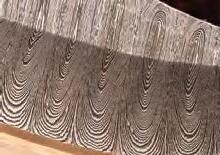
Impossible Price





person who wants to stand out. CALL NOW! If you’re one of the first 700 587 callers for this ad, we’ll throw in a pair of Stauer 8x21 Compact Binoculars — a $99 value — ABSOLUTELY FREE! Satisfaction guaranteed or your money back!
Knife Specifcations:
• 9 ½" overall length. Full-tang construction
• Damascus steel blade and natural pinecone handle
• Genuine leather sheath
Mighty Conifer Knife


EXCLUSIVE FREE
Stauer 8x21 Compact Binoculars a $99 value with your purchase






$299 $99* + S&P Save $200
*You must use Insider Offer Code: MCK186-01 to get this price. California residents please call regarding Proposition 65 regulations before purchasing this product.
1-800-333-2045
Your Insider Offer Code: MCK186-01




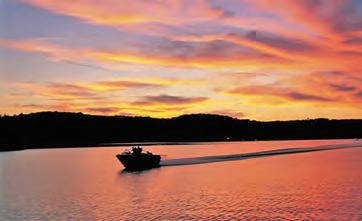

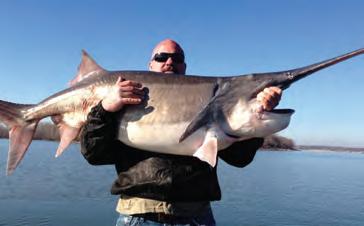
With more than 60,000 surface acres and 1,300 miles of shoreline, Grand Lake O’ the Cherokees is one of the largest outdoor destinations in Oklahoma. Located on the Grand River, the lake is hugely popular with boaters, fishermen, campers and anyone else who loves spending time in the great outdoors. Anglers are sure to have a blast searching for largemouth bass, white bass, crappie, channel catfish, bluegill and the rare paddlefish on Grand Lake waters. And Grand Lake’s shores are lined with so many unique attractions, shops, restaurants, state parks and casinos that seeing everything in one trip is next to impossible. There’s truly something for everyone to love in the Grand Lake Area!

Discover all the fun things to see and do in the Grand Lake Area as well as places to stay, places to eat, festivals and more at GrandLakeFun.com

